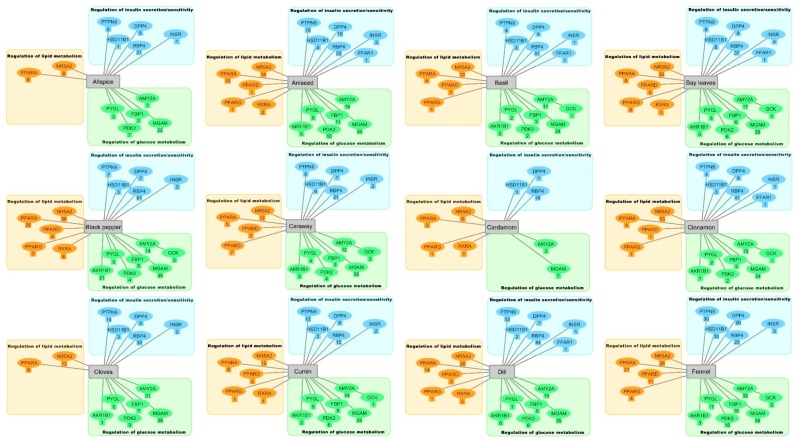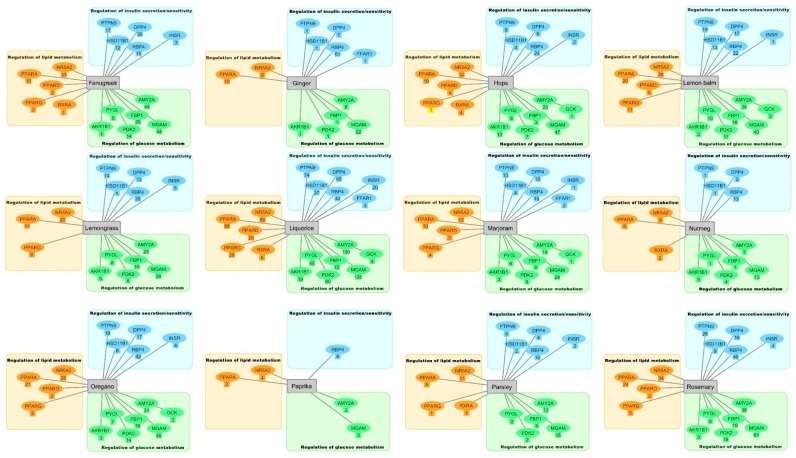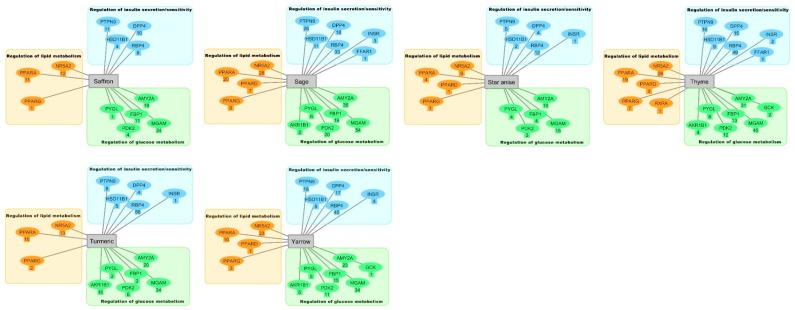Abstract
Culinary herbs and spices are widely used as a traditional medicine in the treatment of diabetes and its complications, and there are several scientific studies in the literature supporting the use of these medicinal plants. However, there is often a lack of knowledge on the bioactive compounds of these herbs and spices and their mechanisms of action. The aim of this study was to use inverse virtual screening to provide insights into the bioactive compounds of common herbs and spices, and their potential molecular mechanisms of action in the treatment of diabetes. In this study, a library of over 2300 compounds derived from 30 common herbs and spices were screened in silico with the DIA-DB web server against 18 known diabetes drug targets. Over 900 compounds from the herbs and spices library were observed to have potential anti-diabetic activity and liquorice, hops, fennel, rosemary, and fenugreek were observed to be particularly enriched with potential anti-diabetic compounds. A large percentage of the compounds were observed to be potential polypharmacological agents regulating three or more anti-diabetic drug targets and included compounds such as achillin B from yarrow, asparasaponin I from fenugreek, bisdemethoxycurcumin from turmeric, carlinoside from lemongrass, cinnamtannin B1 from cinnamon, crocin from saffron and glabridin from liquorice. The major targets identified for the herbs and spices compounds were dipeptidyl peptidase-4 (DPP4), intestinal maltase-glucoamylase (MGAM), liver receptor homolog-1 (NR5A2), pancreatic alpha-amylase (AM2A), peroxisome proliferator-activated receptor alpha (PPARA), protein tyrosine phosphatase non-receptor type 9 (PTPN9), and retinol binding protein-4 (RBP4) with over 250 compounds observed to be potential inhibitors of these particular protein targets. Only bay leaves, liquorice and thyme were found to contain compounds that could potentially regulate all 18 protein targets followed by black pepper, cumin, dill, hops and marjoram with 17 protein targets. In most cases more than one compound within a given plant could potentially regulate a particular protein target. It was observed that through this multi-compound-multi target regulation of these specific protein targets that the major anti-diabetic effects of reduced hyperglycemia and hyperlipidemia of the herbs and spices could be explained. The results of this study, taken together with the known scientific literature, indicated that the anti-diabetic potential of common culinary herbs and spices was the result of the collective action of more than one bioactive compound regulating and restoring several dysregulated and interconnected diabetic biological processes.
Keywords: herbs, spices, anti-diabetic, DIA-DB, virtual screening, sesquiterpenoids, flavonoids
1. Introduction
Diabetes is a chronic disease characterized by an insulin deficiency and/or insulin insensitivity, and was the seventh leading cause of death in 2016 [1,2,3,4]. It is a multi-organ disease affecting the pancreas, liver, muscles, kidney, and central nervous system and several complications such as hypertension, stroke, blindness, and kidney disease are associated with diabetes [5,6]. The main type of treatment for diabetes and controlling the associated hyperglycemia is in the form of insulin that primarily focuses on lowering and maintaining blood glucose levels [5]. However, insulin treatment is rather expensive and a somewhat invasive treatment strategy. In more recent years, since diabetes is a multifaceted disease, there has been an increase in the development of specific protein-targeted drugs, and specific inhibitors for targets like alpha-glucosidase, dipeptidyl peptidase-4 (DPP4), glucagon-like peptide-1 (GLP-1) receptor, and sodium-glucose co-transporter-2 (SGLT2) have been approved [6]. Unfortunately, some of these approved drugs have been met with several adverse effects [6]. As a better understanding of the pathogenesis and complexity in treating the disease arises, so too must the need for the development of more effective and safer drugs to treat the disease.
There is widespread traditional use in several cultures of decoctions prepared from medicinal plants in the treatment of diabetes [7,8,9,10,11]. In Chinese medicine, the belief is to use a more holistic approach that not only focuses on the treatment of the associated hyperglycemia but also on the associated diabetic complications [11]. Various reviews on medicinal plants effective in the treatment of diabetes can be found in the literature. Li et al 2004 reviewed 82 natural plant medicines used in Chinese traditional medicine for treating diabetes and included Radix puerariae, Radix ginseng, Rhizoma anemarrhenae, a mixture of the fruits, leaves and root epidermis of Morus alba, a mixture of Radix paeoniae and Radix paeoniae alba, Allii sativi bulbus, and Gymnema sylvestre [11]. These plants were found to contain more than one bioactive compound that besides improving blood glucose levels also improved the associated hyperlipidemia, improved insulin secretion, exerted antioxidant effects, improved renal function, and also treated diabetic retinopathy and neuropathy. Harlev et al. (2013) reviewed 22 desert and semi-desert plants commonly used in Bedouin ethnic medicine for the treatment of diabetes and included Artemisia herba-alba, Teucrium polium, Ziziphus spina-christi, Larrea tridentate, and Balanites aegyptica [12]. Compounds such as apigenin, cirsimaritin, christinin-A, nordihydroguaiaretic acid, isorhamnetin, and isorhamnetin-3-O-rutinoside were identified from these plants as having anti-diabetic properties. A review by Moradi et al. (2018) lists various medicinal plants found throughout the world that are effective in the treatment of diabetes and includes Trigonella foenum-graecum (India), Ferula assafoetida (Iran and Afghanistan), Bauhinia forficate (Argentina, Brazil and Peru), Combretum micranthum (Africa), Liriope spicata (East Asia and China), Symplocos coccinea (Mexico), as well as Coccinia indica, Allium sativum, and Aloe vera. Burm that are found distributed worldwide [13]. The biochemical mechanisms for the anti-diabetic activity of these plants identified included the stimulation of insulin secretion from pancreatic B-cells, inhibition of intestinal glucose digestion, and absorption as well as the regulation of enzymes such as lipoprotein lipase, glucose-6-phosphatase, lactate dehydrogenase, and aldose reductase.
Plant secondary metabolites such as the flavonoids, terpenoids, alkaloids and polysaccharides that are found widespread in medicinal plants have been extensively studied for their anti-diabetic activity [14,15,16,17]. The flavonoids like quercetin, myricetin, kaempferol, and genistein have been found to protect pancreatic B-cells from damage, stimulate insulin secretion from B-cells, promote glucose uptake by the peripheral tissues, inhibit alpha-glucosidase and alpha-amylase, as well as promote glycogenesis [14]. Flavonoids have also been shown to have beneficial effects against diabetic complications such as diabetes-related cardiovascular disease, diabetic neuropathy, and retinopathy. Similarly, the terpenoids oleanolic acid, corosolic acid, betulinic acid, glycyrrhetinic acid, and gymnemic acid; the alkaloids berberine, catharanthine, vindoline, cryptolepine and trigonelline as well as polysaccharides isolated from tea, mulberry, ginseng, pumpkin, peach-gum, and guava have shown a diverse range of anti-diabetic effects in vitro and in vivo [15,16,17].
Herbs and spices are widely used in our daily lives as important seasonings and flavorings for our food. They are also commonly used for their health benefit properties such as antioxidant, anti-inflammatory, anticancer, anti-diabetic, antimicrobial, neuroprotective, and cardiovascular effects [18,19,20,21,22,23]. They represent attractive therapeutics interventions as they are complex mixtures of diverse compounds that can potentially and cooperatively modulate the activity of several dysregulated and interconnected disease targets. They are also widely available and are fairly inexpensive, with the exception of perhaps saffron. Although several studies can be found on the anti-diabetic activity of some of herbs and spices and in certain cases extensive scientific evaluations have been conducted, for the majority however, there is still a lack of scientific knowledge. The aim of this study was to provide insights into the bioactive compounds of these plants, as well as their molecular anti-diabetic mechanisms of action.
In silico virtual screening methodologies are ideal for exploratory evaluations of the potential anti-diabetic activity of medicinal plants. As plants are complex mixtures of several different compounds, with in silico virtual screening methods, hundreds of compounds can be screened against multiple diabetes targets rapidly and cost effectively. This strategy has been employed to identify anti-cancer, anti-stroke, and anti-Alzheimer’s compounds from traditional Chinese medicines as well as their potential mechanisms of action [24,25,26]. In this study, we have implemented similar in silico methodologies to evaluate the anti-diabetic activity of 30 common herbs and spices.
2. Results and Discussion
2.1. Literature Review
The anti-diabetic activity of some common herbs and spices were evaluated in this study with inverse virtual screening against 18 anti-diabetic drug targets with the DIA-DB web server. The aim of this study was to identify the bioactive compounds of these plants and provide insights into their molecular anti-diabetic mechanisms. Several studies can be found on the anti-diabetic activity of some of these herbs and spices, and the significant studies are summarized in Table 1 for in vivo and in vitro studies.
Table 1.
Literature review on the in vitro and in vivo anti-diabetic activity of various herbs and spices.
| Plant Name | Common Name | Part Evaluated | In Vitro Anti-Diabetic Effects | In Vivo Anti-Diabetic Effects | References |
|---|---|---|---|---|---|
| Pimenta Dioica | Allspice | Berries | Alpha-glucosidase and alpha-amylase inhibitory, increased insulin-stimulated glucose metabolism in adipocytes | Streptozotocin-induced diabetic rats-improves antioxidant status | [27,28,29] |
| Pimpinella anisum | Aniseed | Seeds | Alpha-glucosidase, alpha-amylase, HMGR and pancreatic lipase inhibitory activity | Diabetic patients-reduced hyperglycemia, reduced hyperlipidemia, improved antioxidant status | [30,31,32] |
| Ocimum basillicum | Basil | Leaves | Alpha-glucosidase, alpha-amylase, aldose reductase, pancreatic lipase inhibitory activity, increases insulin-stimulated glucose metabolism in adipocytes, increase GLUT4 translocation | Alloxan/streptozotocin-induced diabetic rats-reduced hyperglycemia, reduced hyperlipidemia, improved antioxidant status, increased liver glycogen content, improved liver function | [27,33,34,35,36,37,38,39,40,41,42] |
| Laurus nobilis | Bay leaves | Leaves | Alpha-glucosidase inhibitory activity; increases insulin-stimulated glucose metabolism in adipocytes | Type 2 diabetic patients-reduced hyperglycemia, reduced hyperlipidemia | [27,43,44,45] |
| Piper nigrum | Black pepper | Fruit and leaves | Alpha-glucosidase, alpha-amylase and aldose reductase inhibitory activity, increased glucose consumption by adipocytes, induced transactivation of PPARA | Alloxan/streptozotocin-induced diabetic rats-reduced hyperglycemia, reduced hyperlipidemia, increased serum insulin levels, improved antioxidant status, improved liver function | [40,42,46,47,48,49,50,51,52,53,54] |
| Carum carvi | Caraway | Fruit/seeds | Induced transactivation of PPARA | Alloxan/streptozotocin-induced diabetic rats-reduced hyperglycemia, reduced hyperlipidemia, increased serum insulin levels, improved antioxidant status | [49,55,56,57,58,59] |
| Elettaria cardamomum | Cardamom | Seeds and leaves | No significant studies identified | Alloxan-induced diabetic rats-reduced hyperglycemia, reduced hyperlipidemia, decreased plasma insulin levels, improved liver function | [60,61,62,63] |
| Cinnamomum verum | Cinnamon | Bark | Alpha-glucosidase, alpha-amylase, aldose reductase inhibitory activity, increased insulin-stimulated glucose metabolism in adipocytes, increased expression and translocation of GLUT4 and GLUT1, induced transactivation of PPARA and PPARG | Alloxan/streptozotocin-induced diabetic rats-reduced hyperglycemia, reduced hyperlipidemia, increased plasma insulin levels, improved liver function, increased GLP1 levels, increased pyruvate kinase activity, decreased PEPCK activity | [27,42,60,64,65,66,67,68,69] |
| Syzygium aromaticum | Clove | Flower buds | Alpha-glucosidase, alpha-amylase, PEPCK and G6Pase inhibitory activity, increased insulin-stimulated glucose metabolism in adipocytes, induced transactivation of PPARG | Streptozotocin-induced diabetic rats-reduced hyperglycemia, reduced hyperlipidemia, improved antioxidant status, improved liver function, reduced expression of GLUT2, SGLT1, alpha-amylase and alpha-glucosidase in rat small intestine, increased glycogen content of liver and muscles, increased activity of hexokinase in liver and muscle | [27,68,69,70,71,72,73,74,75,76,77,78,79] |
| Cuminum cyminum | Cumin | Seeds | Alpha-glucosidase, alpha-amylase, aldose reductase inhibitory activity, induced transactivation of PPARG, stimulated glucose uptake in myotubes | Streptozotocin-induced diabetic rats-reduced hyperglycemia, reduced hyperlipidemia, reduced/ increased serum insulin levels depending on model, improved antioxidant status, increased liver and skeletal muscle content | [42,70,80,81,82,83,84,85] |
| Anethum graveolens | Dill | Aerial parts and seeds | No significant studies identified | Alloxan/streptozotocin-induced diabetic rats-reduced hyperglycemia, reduced hyperlipidemia, improved antioxidant status | [86,87,88,89] |
| Foeniculum vulgare | Fennel | Seeds and leaves | Alpha-glucosidase, alpha-amylase, aldose reductase inhibitory activity, increased glucose consumption by adipocytes | Alloxan/streptozotocin-induced diabetic rats-reduced hyperglycemia, reduced hyperlipidemia, increased serum insulin levels, improved antioxidant status, improved liver function, increased liver glycogen content, increased liver and kidney hexokinase activity | [40,42,90,91,92,93,94,95] |
| Trigonella foenum-graecum | Fenugreek | Seeds | Alpha-glucosidase, alpha-amylase, aldose reductase, pancreatic lipase inhibitory activity, induced transactivation of PPARG, PPARD and PPARA | Alloxan/streptozotocin-induced diabetic rats-reduced hyperglycemia, reduced hyperlipidemia, increased serum insulin levels, improved antioxidant status, improved liver function, increased liver, muscle and kidney glycogen content, reduced activity of intestinal maltase, sucrase and lactase, intestinal lipase, alpha-amylase, glycogen phosphorylase and G6Pase, increased activity of glycogen synthase, hexokinase, PPARG, PPARA and glucose-6-phosphate dehydrogenase | [42,69,96,97,98,99,100,101,102,103,104,105,106] |
| Zingiber officinale | Ginger | Root | Alpha-glucosidase, alpha-amylase, aldose reductase, pancreatic lipase inhibitory activity, increased GLUT4, increased glucose consumption by adipose tissues | Alloxan/streptozotocin-induced diabetic rats-reduced hyperglycemia, reduced hyperlipidemia, increased serum insulin levels, improved liver function, increased activity of liver glucokinase, phosphofructokinase, and pyruvate kinase | [65,101,107,108,109,110,111,112] |
| Humulus lupulus | Hops | Cones and leaves | Alpha-glucosidase, alpha-amylase, aldose reductase, pancreatic lipase inhibitory activity, induced PPARG and PPARA transactivation; induced FXR activity | Streptozotocin-induced diabetic rats-reduced hyperglycemia, reduced hyperlipidemia, increased hepatic glycogen content, reduced expression of hepatic GLUT2 and hepatic acetyl-CoA carboxylase, increased hepatic FAS expression. Diabetic KK-Ay mice-reduced hyperglycemia, reduced hyperlipidemia, increased expression of acyl-CoA oxidase, fatty acid translocase, lipoprotein lipase and PPARA, reduced expression of SRE-BP1, FAS, AceCS, SCD-1, ACL, PEPCK, G6Pase, and FBP1. | [113,114,115,116,117,118,119,120] |
| Melissa officinalis | Lemon balm | Leaves | Alpha-glucosidase, alpha-amylase, pancreatic lipase inhibitory activity, induced activation of PPARA, PPARD, and PPARG, increased glucose consumption through adipocytes, increased expression of SREBP1, FABP4, fatty acid transport protein 4, CD36 molecule, PDK4, LXRA, lipogenic stearoyl CoA desaturase | Alloxan/streptozotocin-induced diabetic rats-reduced hyperglycemia, reduced hyperlipidemia, increased serum insulin levels | [40,101,121,122,123,124,125] |
| Cymbopogon citratus | Lemongrass | Leaves | Alpha-glucosidase, alpha-amylase, aldose reductase inhibitory activity | Poloxamer-47-induced type 2 diabetic rats-reduced hyperglycemia, reduced hyperlipidemia, reduced serum insulin levels and insulin resistance, improved antioxidant status, increased GLP1 expression | [126,127,128,129,130] |
| Glycyrrhiza glabra | Liquorice | Root | Alpha-glucosidase, alpha-amylase, aldose reductase, PTP1B inhibitory activity, induced PPARG activation, increased insulin-stimulated glucose uptake by adipocytes, stimulated glucose-mediated insulin secretion from pancreatic islet cells, increased the expression of PDX-1 and GCK | Streptozotocin-induced diabetic rats-reduced hyperglycemia, reduced hyperlipidemia, increased/decreased serum insulin levels depending on model, improved antioxidant status, improved liver function, increased liver glycogen content, increased expression of PPARG and GLUT4 in muscles | [64,131,132,133,134,135,136,137,138,139,140,141,142,143] |
| Origanum marjorana | Marjoram | Leaves | Alpha-glucosidase, aldose reductase, DPP4, PTP1B inhibitory activity, induced activation of PPARA and PPARG; | Streptozotocin-induced diabetic rats-reduced hyperglycemia, reduced hyperlipidemia, increased/ decreased serum insulin levels depending on model, improved liver function, increased liver glycogen content, increased expression of adiponectin, lipoprotein lipase and PPARG in adipose tissue, decreased expression of leptin | [84,144,145,146,147,148,149] |
| Myristica fragrans | Nutmeg | Seed | Alpha-glucosidase, alpha-amylase, PTP1B inhibitory activity, induced PPARG and PPARA activation, increased expression of lipoprotein lipase, FAS, aP2, IRS2, CEBPA, GLUT4, CD36, CPT-1, PDK4, and acyl-CoA oxidase, stimulated phosphorylation of AMPK in myoblasts, stimulated the release of insulin from islet cells, increased phosphorylation of insulin receptor in myeloid cells | Alloxan/streptozotocin-induced diabetic rats-reduced hyperglycemia, reduced hyperlipidemia, reduced serum insulin levels, increased expression of CD36, CPT-1, PDK4, acyl-CoA oxidase, lipoprotein lipase, glycerol kinase in adipose tissue, increased expression of CPT-1, LPL, ACO and CYP4A in the liver | [49,81,150,151,152,153,154,155,156] |
| Origanum vulgare | Oregano | Leaves | Alpha-glucosidase, alpha-amylase, aldose reductase, DPP4, PTP1B inhibitory activity, induced activation of PPARG and PPARD; stimulated insulin-dependent glucose uptake in adipocytes | Alloxan/streptozotocin-induced diabetic rats-reduced hyperglycemia, reduced hyperlipidemia, increased serum insulin levels, increased liver and muscle glycogen content, reduced pancreatic alpha-amylase activity | [102,121,144,157,158,159,160,161] |
| Capsicum annuum | Paprika | Fruits | Alpha-glucosidase, alpha-amylase inhibitory activity | Alloxan-induced diabetic rats-reduced hyperglycemia, reduced hyperlipidemia | [162,163,164] |
| Petroselinum crispum | Parsley | Leaves | No significant studies identified | Streptozotocin-induced diabetic rats-reduced hyperglycemia, reduced hyperlipidemia, increased serum insulin levels, improved antioxidant status, improved liver function, increased liver and muscle glycogen content, increased liver pyruvate kinase activity | [165,166,167,168,169] |
| Rosmarinus officinalis | Rosemary | Leaves | Alpha-glucosidase, alpha-amylase, pancreatic lipase, DPP4, PTP1B inhibitory activity, induced activation of PPARG, increased glucose consumption by adipocytes, increased AMPK phosphorylation in liver cells; decreased expression of G6Pase and acetyl-CoA carboxylase B, increased expression of low-density lipoprotein receptor, SIRT1 and PPARG-coactivator 1, promoted GLUT4 translocation | Alloxan/streptozotocin-induced diabetic rats-reduced hyperglycemia, reduced hyperlipidemia, increased serum insulin levels, improved antioxidant status, improved liver function, reduced intestinal glucosidase activity, modulated activity of hexokinase, pyruvate kinase, G6Pase, FBP1, and glycogen metabolism | [40,64,68,101,144,161,170,171,172,173,174,175,176,177] |
| Crocus sativus | Saffron | Flower | Stimulated glucose uptake by skeletal muscle cells, increased phosphorylation of AMPK, increased GLUT4 translocation, induced activation of PPARA | Alloxan/streptozotocin-induced diabetic rats-reduced hyperglycemia, reduced hyperlipidemia, increased serum insulin levels, improved antioxidant status improved liver, kidney and pancreatic B-cell function | [178,179,180,181,182,183,184] |
| Salvia officinalis | Sage | Leaves | Alpha-glucosidase, alpha-amylase inhibitory activity, induced activation of PPARG, stimulated insulin-dependent glucose uptake in adipocytes | Alloxan/streptozotocin-induced diabetic rats-reduced hyperglycemia, reduced hyperlipidemia, increased serum insulin levels, improved liver and kidney function, increased GLUT4 expression | [62,102,121,185,186,187,188] |
| Illicium verum | Star anise | Fruits and seeds | Alpha-glucosidase inhibitory activity | Streptozotocin-induced diabetic rats-improved oral glucose tolerance test | [152] |
| Thymus vulgaris | Thyme | Aerial parts | Alpha-glucosidase inhibitory activity, induced activation of PPAR, stimulated glucose uptake by adipocytes and myotubes | Alloxan/streptozotocin-induced diabetic rats-reduced hyperglycemia, reduced hyperlipidemia, improved antioxidant status, improved liver and kidney functions | [102,189,190,191,192,193] |
| Curcuma longa | Turmeric | Roots | Alpha-glucosidase, alpha-amylase, aldose reductase inhibitory activity, induced activation of PPARG, stimulated insulin secretion from pancreatic cells, stimulated glucose uptake in muscle tissue | Alloxan/streptozotocin-induced diabetic rats/ KK-Ay diabetic mice-reduced hyperglycemia, reduced hyperlipidemia, increased in serum insulin levels, improved antioxidant status, improved liver function, increased activity of cholesterol-7a-hydroxylase and hepatic HMGR | [67,80,194,195,196,197,198,199,200,201,202,203,204,205,206] |
| Achillea millefolium | Yarrow | Aerial parts | Alpha-glucosidase inhibitory activity, increased expression of PPARG and GLUT4, stimulated insulin secretion by pancreatic cells | Alloxan/streptozotocin-induced diabetic rats-reduced hyperglycemia, reduced hyperlipidemia, increased serum insulin levels, improved liver and pancreas function | [207,208,209] |
AceCS: acetyl-CoA synthetase 2; ACO: 1-aminocyclopropane-1-carboxylic acid oxidase; ACL: adenosine triphosphate citrate lyase; AMPK: 5’ adenosine monophosphate-activated protein kinase; CD36: cluster of differentiation 36; CEBPA: CCAAT/enhancer-binding protein alpha; CPT1: carnitine palmitoyltransferase-I; CYP4a: cytochrome P450 4A; DPP4: dipeptidyl peptidase 4; FABP4: fatty acid binding protein 4; FAS: fatty acid synthase; FBP1: fructose-1,6-bisphosphatase; FXR: farnesoid X receptor; G6Pase: glucose-6-phosphatase; GCK: glucokinase; GLP1: glucagon-like peptide 1; GLUT1/2/4: glucose transporter type 1/2/4; HMGR: 3-hyroxy-3-methyl-glutaryl-CoA reductase; IRS2: insulin receptor substrate 2; LPL: lipoprotein lipase; LXRA: liver X receptor alpha; PDX1: insulin promoter factor 1; PDK4: pyruvate dehydrogenase lipoamide kinase isozyme 4; PEPCK: phosphoenolpyruvate carboxykinase; PPARA/D/G: peroxisome proliferator-activated receptor alpha/delta/gamma; PTP1B: protein tyrosine phosphatase non-receptor type 1; SCD: stearoyl-CoA desaturase; SGLT1: sodium-glucose co-transporter-1; SIRT1: sirtuin 1; SREBP1: sterol regulatory element-binding protein 1.
The primary in vivo model identified for studying the anti-diabetic activity of these plant extracts was either streptozotocin-induced or alloxan-induced diabetic rats. Aniseed [32], bay leaves [44,45,210], cardamom [211], cinnamon [66,211], cumin [212,213], dill [214], ginger [211], hops [118], rosemary [215], saffron [211,216], sage [217,218], and turmeric [219] have also been evaluated in type 2 diabetic patients. The major in vivo effects observed for the herbs and spices are a reduction in hyperglycemia and hyperlipidemia. The hyperglycemia observed in diabetes is the result of pancreatic dysfunction and insulin resistance, and is associated with unbalanced rates of glycogenolysis and gluconeogenesis resulting in increased endogenous glucose production [220]. The reduction in hyperlipidemia was observed as decreases in total cholesterol, low-density lipoprotein (LDL), very-low-density lipoprotein (VLDL) and triglyceride levels with an increase in the high-density lipoprotein (HDL) levels. Diabetes is characterized by low plasma HDL and high triglycerides, cholesterol, and LDL levels [221]. Increased levels of LDL inhibit insulin secretion and induce pancreatic B-cell apoptosis, while an increase in HDL protects against apoptosis and improves B-cell function, reduces plasma glucose and increases plasma insulin. An accumulation of triglycerides in the liver, pancreas, and muscles is correlated with insulin resistance and the cholesterol levels in adipocytes increase with increasing levels of triglycerides [222].
With the effect on serum insulin levels, the type of model used namely type 1 or type 2 diabetic model plays a role. This is particularly seen with cumin, liquorice, and marjoram that can increase or decrease serum insulin levels depending on the insulin status of the control diabetic rat model. Type 1 diabetes is associated with an insulin deficiency while in type 2 diabetes normal insulin or raised insulin levels are observed with significant insulin resistance [1,2,3]. Type 2 diabetes, however, may eventually progress to an insulin deficient state following pancreatic B-cell dysfunction as a result of exhaustive insulin production and secretion [2]. The herbs and spices observed to raise the serum insulin levels and have possible benefits in the treatment of insulin-deficient diabetes were black pepper, caraway, fennel, fenugreek, ginger, lemon balm, oregano, parsley, rosemary, saffron, sage, turmeric, and yarrow. Cardamom, cinnamon, dill, lemongrass, and nutmeg were found to decrease serum insulin levels and may be beneficial in the treatment of hyperinsulinemia type diabetes.
Some detailed studies exploring the in vivo anti-diabetic activity of some of the herbs and spices can be seen in Table 1. This is true for cinnamon, clove, fenugreek, hops, liquorice, marjoram, ginger, nutmeg, rosemary, and turmeric, where authors have evaluated the specific effects of these extracts on the expression and activity of some anti-diabetic drug targets like phosphoenolpyruvate carboxykinase (PEPCK), PPARA/G, glucose 6-phosphatase (G6Pase), glucose transporter type 4/2 (GLUT4/2), pyruvate kinase, alpha-amylase, alpha-glucosidase, SGLT1, hexokinase, lipoprotein lipase, fatty acid synthase, and fructose-1,6-bisphosphatase (FBP1). For the majority of the herbs and spices presented here, however, very little is known regarding their observed anti-diabetic activity.
The major in vitro studies have focused on the inhibitory activity of the herbs and spices on alpha-glucosidase and alpha-amylase in particular yeast or rat intestinal alpha-glucosidase and porcine pancreatic alpha-amylase (Table 1). Alpha-amylase is responsible for the digestion of dietary starch to maltase that in turn is digested into glucose by intestinal alpha-glucosidase. Inhibition of these two enzymes will delay carbohydrate digestion thus lowering the postprandial blood glucose level [223]. Majority of the herbs and spices were found to inhibit these two enzymes regulating carbohydrate metabolism. However, varying levels of activity could be found for a single plant dependent on extract preparation and assay conditions, with some studies showing a high level of inhibitory activity, while no activity was observed in other studies. This has also been noted in a detailed review on the alpha-glucosidase and alpha-amylase inhibitory activity of several medicinal plants [68]. The inhibitory activity of some herbs and spices on other diabetic targets such as pancreatic lipase and aldose reductase as well as transactivation of the PPARs was also observed.
For some herbs and spices, individual bioactive compounds have also been identified and include piperine for black pepper [50,54], cinnamaldehyde and cinnamatannin B1 for cinnamon [66], dehydrodieugenol, dehydrodieugenol B, oleanolic acid and maslinic acid for clove [74,77], cuminaldehyde for cumin [82], diosmin, [6]-gingerol, carvacrol and thymol for ginger [107,112], 3′-geranylchalconaringenin, xanthohumol, isohumulone and isocohumulone for hops [114,117,118], citronellol for lemongrass [127], glycyrrhizin, 18b-glycyrrhetinic acid, liquiritigenin, isoliquiritigenin, glabridin and licochlacone A for liquorice [131,133,134,135,137,138,143], 6-hydroxyapigenin for marjoram [145], macelignan, licarin B, tetrahydrofuroguaiacin B, nectandrin B, nectandrin A and dihydroguaiaretic acid for nutmeg [149,151,153,154], rosmarinic acid and salvianolic acid B for oregano [159], capsaicin for paprika [164], rosmarinic acid, carnosol, carnosic acid, luteolin, 7-O-methylrosmanol, hispidulin, and cirsimaritin for rosemary [144], safranal and crocin for saffron [180], and ar-turmerone, curcumin, demethoxycurcumin, bisdemethoxycurcumin, and tumerin for turmeric [194,195,198]. Considering that herbs and spices are complex mixtures of diverse compounds, it is likely that the anti-diabetic activity of a given plant is dependent on multiple compounds regulating the activity of several anti-diabetic drug targets. This can be seen for clove, ginger, hops, liquorice, nutmeg, rosemary, and turmeric, where more than one compound has been identified as being the potential bioactive compound responsible for the observed anti-diabetic effects of these plants.
2.2. Inverse Virtual Screening with the DIA-DB Web Server
A compound library of over 2300 compounds from literature was generated for the herbs and spices presented in this study and the compounds were subsequently screened with the DIA-DB webserver (http://bio-hpc.eu/software/dia-db/). The DIA-DB webserver employs inverse virtual screening of compounds with Autodock Vina against a given set of 18 protein targets associated with diabetes [224]. These targets were aldose reductase (AKR1B1), AMY2A, DPP4, FBP1, free fatty acid receptor 1 (FFAR1), glucokinase (GCK), 11B-hydroxysteroid dehydrogenase type 1 (HSD11B1), insulin receptor (INSR), MGAM, NR5A2, pyruvate dehydrogenase kinase isoform 2 (PDK2), PPARA, PPARD, PPARG, PTPN9, liver glycogen phosphorylase (PYGL), RBP4, and retinoid X receptor alpha (RXRA). The major function of each of the protein targets can be found in Table 2 and have been broadly divided into three categories representing either their mode of action on insulin secretion and/or sensitivity, regulation of glucose metabolism, or regulation of lipid metabolism. Although these protein targets have been broadly divided into three major categories, their activity can be interconnected with one or more protein targets found in a different category. This is observed from evidence in literature on the regulation of GCK by NR5A2 and PPARG [225], GCK can act as a glucose sensor in pancreatic B-cells and stimulate insulin secretion [226], regulation of PDK2 activity by PPARA and PPARD [227], FFAR1 regulation by PPARG [228], HSD11B1 regulation by PPARG [229], and PPARG can promote insulin sensitivity by enhancing the expression and translocation of the GLUT transporters responsible for glucose uptake [229].
Table 2.
The major biological functions of the DIA-DB protein targets, the docking cutoff score, and the total number of potential inhibitors identified for each target.
| Mode of Action | Protein Target | Function | PDB Code | Average Docking Score of Known Drugs (kcal/mol) | Docking Cutoff (kcal/mol) | Total Number of Potential Inhibitors |
|---|---|---|---|---|---|---|
| Regulation of insulin secretion and sensitivity | DPP4 | Degrades and inactivates glucagon-like peptide-1 that stimulates insulin secretion from pancreas [231] | 4A5S | −8.50 | −9.00 | 260 |
| FFAR1 | Binding of free fatty acids to receptor results in increased glucose-stimulated insulin secretion [232] | 4PHU | −10.00 | −10.50 | 6 | |
| HSD11B1 | Coverts inactive glucocorticoid precursors to active glucocorticoids; glucocorticoids counteract the effects of insulin [233] | 4K1L | −9.40 | −10.00 | 114 | |
| INSR | Regulates glucose uptake as well as glycogen, lipid, and protein synthesis [231] | 3EKN | −8.60 | −9.00 | 47 | |
| PTPN9 | Dephosphorylates the insulin receptor, thereby reducing insulin sensitivity [234] | 4GE6 | −7.80 | −8.00 | 246 | |
| RBP4 | Secreted as an adipokine that reduces insulin signaling and promotes gluconeogenesis [235] | 2WR6 | −7.40 | −8.00 | 412 | |
| Regulation of glucose metabolism | AKR1B1 | Catalyzes the reduction of glucose to sorbitol in the polyol pathway, plays a role in diabetic complications [236] | 3G5E | −9.95 | −10.50 | 96 |
| AMY2A | Hydrolyzes alpha-1,4-glycosidic bonds of starch during digestion of starch to glucose [237] | 4GQR | −7.60 | −8.00 | 429 | |
| FBP1 | Catalyzes the second last step in gluconeogenesis [220] | 2JJK | −5.40 | −6.00 | 210 | |
| GCK | Phosphorylates glucose to glucose-6-phosphate for glycolysis or glycogen synthesis [234] | 3IMX | −9.40 | −10.00 | 18 | |
| MGAM | Hydrolyzes 1,4-alpha bonds, the last step in the digestion of starch to glucose [237] | 3L4Y | −6.50 | −7.00 | 592 | |
| PDK2 | Responsible for inactivating the pyruvate dehydrogenase complex that is involved in glucose oxidation [238] | 4MPC | −7.90 | −8.00 | 190 | |
| PYGL | Catalyzes the first step of glycogenolysis by the phosphorolysis of glycogen to glucose-1-phosphate [239] | 3DDS | −8.10 | −8.50 | 113 | |
| Regulation of lipid metabolism | NR5A2 | Regulates the expression of genes involved in bile acid synthesis, cholesterol synthesis, and steroidogenesis [240] | 4DOR | −7.50 | −8.00 | 362 |
| PPARA | Regulates expression of genes involved in lipid metabolism, in particular, the oxidation of fatty acids as well as lipoprotein assembly and lipid transport [241] | 3FEI | −7.60 | −8.00 | 271 | |
| PPARD | Regulates expression of genes involved in fatty acid catabolism [241] | 3PEQ | −9.30 | −10.00 | 60 | |
| PPARG | Regulates expression of genes involved in adipogenesis and lipid metabolism particularly fatty acid transport, lipid droplet formation, triacyglycerol metabolism, as well as lipolysis of triglycerides [241] | 2FVJ | −9.70 | −10.00 | 75 | |
| RXRA | Heterodimerizes with PPARs, thereby initiating gene transcription [241] | 1FM9 | −9.95 | −10.00 | 24 |
Aldose reductase (AKR1B1), dipeptidyl peptidase-4 (DPP4), free fatty acid receptor 1 (FFAR1), fructose-1,6-bisphosphatase (FBP1), glucokinase (GCK), hydroxysteroid 11-beta dehydrogenase 1 (HSD11B1), insulin receptor (INSR), intestinal maltase-glucoamylase (MGAM), liver glycogen phosphorylase (PYGL), liver receptor homolog-1 (NR5A2), pancreatic alpha-amylase (AMY2A), peroxisome proliferator-activated receptor alpha (PPARA), peroxisome proliferator-activated receptor delta (PPARD), peroxisome proliferator-activated receptor gamma (PPARG), protein tyrosine phosphatase, non-receptor type 9 (PTPN9), pyruvate dehydrogenase kinase isoform 2 (PDK2), retinoid X receptor alpha (RXRA), and retinol binding protein 4 (RBP4).
A cutoff docking score for each of the protein targets was set to distinguish potentially active compounds from the inactive ones. The cutoff docking score was decided on by the average docking score obtained for known and/or experimental drugs together with the crystallized ligand found in the active site of a given protein target (Table S1). The cutoff docking scores set for each of the protein targets can be found in Table 2 as well as the total number of compounds identified as potential inhibitors for each of the targets. Of the library compounds submitted to the DIA-DB web server over 940 compounds were identified as potential anti-diabetic bioactive compounds. The herbs and spices presented here were thus found to be very rich sources of anti-diabetic compounds. Over 200 potential agonists/inhibitors were identified for protein targets AMY2A, DPP4, FBP1, MGAM, NR5A2, PPARA, and RBP4.
A summary of the inverse virtual screening results can be found in Table 3. Table S2 contains the full list of bioactive compounds identified and their source plants. As can be seen for majority of the herbs and spices, the number of compounds found to be potentially responsible for the observed anti-diabetic activity accounted for 30%–50% of the total number of compounds submitted. More than half of the compounds submitted for liquorice, hops, fennel, and rosemary were found to be potential bioactive compounds with 73%, 61%, 54%, and 54%, respectively. This is also represented in the literature, where a large volume of detailed studies on the anti-diabetic activity of these plants can be found. Only a few (9%) of the 166 compounds submitted for paprika were found to be potential bioactive compounds. This is also reflected in the literature on the anti-diabetic activity of paprika (Capsicum annuum), where only a few studies were found and the activity noted was somewhat moderate. Surprisingly, allspice and yarrow where only a few studies on their anti-diabetic activity can be found, had a high percentage 49% of potential bioactive compounds that were identified.
Table 3.
Summary of DIA-DB inverse virtual screening results for various herbs and spices.
| Plant Name | Total Number of Compounds Evaluated | Total Number of Potential Anti-Diabetic Compounds (% of Total) | Compounds with 3 or More Targets |
|---|---|---|---|
| Allspice | 84 | 41 (49%) | 13 |
| Aniseed | 125 | 50 (40%) | 23 |
| Basil | 214 | 58 (27%) | 15 |
| Bay leaves | 179 | 69 (39%) | 19 |
| Black Pepper | 183 | 84 (46%) | 31 |
| Caraway | 185 | 43 (23%) | 15 |
| Cardamom | 141 | 29 (21%) | 2 |
| Cinnamon | 74 | 26 (35%) | 18 |
| Clove | 147 | 59 (40%) | 21 |
| Cumin | 146 | 38 (26%) | 19 |
| Dill | 168 | 65 (39%) | 27 |
| Fennel | 123 | 66 (54%) | 42 |
| Fenugreek | 110 | 55 (50%) | 47 |
| Ginger | 326 | 80 (25%) | 8 |
| Hops | 98 | 60 (61%) | 32 |
| Lemon balm | 118 | 53 (45%) | 35 |
| Lemongrass | 132 | 55 (42%) | 28 |
| Liquorice | 215 | 157 (73%) | 135 |
| Marjoram | 103 | 31 (30%) | 18 |
| Nutmeg | 96 | 25 (26%) | 9 |
| Oregano | 177 | 71 (40%) | 34 |
| Paprika | 166 | 15 (9%) | 0 |
| Parsley | 78 | 28 (36%) | 12 |
| Rosemary | 158 | 85 (54%) | 43 |
| Saffron | 146 | 34 (23%) | 21 |
| Sage | 162 | 80 (49%) | 35 |
| Star anise | 69 | 27 (39%) | 10 |
| Thyme | 204 | 78 (38%) | 38 |
| Turmeric | 239 | 110 (46%) | 29 |
| Yarrow | 148 | 72 (49%) | 27 |
A relative low number of bioactive compounds were identified for ginger (25%). This was unexpected as several detailed studies can be found for the anti-diabetic activity of this particular plant. This indicates that the targets identified here can only partly explain the observed anti-diabetic activity of ginger and that the effect of ginger on other anti-diabetic targets such as pancreatic lipase, GLUT4, phosphofructokinase, and pyruvate kinase also account for the observed reduction in hyperglycemia and hyperlipidemia. This is true for all the herbs and spices presented in this study, as diabetes as a disease is a complex one involving multiple dysregulated processes across several organ systems like the liver, muscles, adipose tissue, and pancreas [5,230]. This indicates that the regulation of various protein targets is needed and that the effect on protein targets other than those presented here may also play a role. This study, however, has provided new insights into the anti-diabetic activity of ginger as well as identified new potential protein targets for the bioactive compounds of ginger. Also, of note is that the bioactive compounds identified in this study were the gingerols and shogaols that have been identified in the literature as the major bioactive compounds of ginger.
Since diabetes is such a complex disease process, the need arises for multi-targeted compounds rather than a “single target–single drug approach” [242,243,244]. This is also why plants such as the herbs and spices presented here are attractive treatments for diabetes as multiple protein targets can be regulated with more than one compound. In this study nearly half of the herbs and spices were found to contain a large percentage of multi-protein-targeted compounds and included cinnamon, cumin, fennel, fenugreek, lemon balm, lemongrass, liquorice, marjoram, oregano, rosemary, saffron, sage, ad thyme.
The major anti-diabetic effects observed in the literature were a reduction in hyperglycemia, reduction in hyperlipidemia, and regulation of insulin secretion. In Figure 1, the effects of the individual herbs and spices on these three diabetes hallmarks dependent on the protein targets of the DIA-DB webserver can be seen. All the herbs and spices were found to be potential regulators of 12 or more of the protein targets with the exception of paprika and cardamom, whose compounds were only found to be potential regulators of 5 and 9 targets, respectively. The reduction in hyperglycemia can be attributed to regulation of the protein targets involved in glucose metabolism. Inhibition of AMY2A and MGAM will delay carbohydrate digestion, thus lowering the postprandial blood glucose level [223]. Inhibition of FBP1 and PYGL will inhibit endogenous glucose production by the liver through the inhibition of gluconeogenesis and glycogenolysis, respectively, thereby reducing blood glucose levels [220]. The PDKs are upregulated in diabetes and are responsible for inhibiting the pyruvate dehydrogenase kinase complex that in turn is responsible for the conversion of pyruvate into acetyl-CoA that then enters the Krebs cycle [245]. By inhibiting PDK2, the serum glucose levels can be reduced through the inhibition of pyruvate availability for liver gluconeogenesis [246]. Activation of GCK will also lead to a reduction in serum glucose levels by promoting glycogenesis and glycolysis through the phosphorylation of glucose to glucose-6-phosphate [226].
Figure 1.
Protein-compound target networks identified for each herb and spice. The number below each protein target denotes the number of potential bioactive compounds identified.
The reduction in the observed hyperlipidemia can be attributed to regulation of the protein targets NR5A2, the PPARs and RXRA that are involved in lipid metabolism. The PPARs play various roles in lipid metabolism by regulating the genes involved in lipogenesis, triglyceride synthesis, reverse cholesterol transport, lipolysis, and fatty acid oxidation. Stimulation of PPARG induces the expression of cluster of differentiation 36 (CD36) that promotes the removal of oxidized LDL from the blood by the macrophages [247]. PPARG also induces the expression of the liver X receptor (LXR) that in turn induces the expression of the reverse cholesterol transporter ABCA1 which releases HDL into the bloodstream, where the cholesterol is converted to bile salts in the liver and is subsequently excreted. PPARG also promotes adipogenesis forming new adipocytes that are able to take up excess lipids from the plasma while promoting apoptosis of lipid-saturated adipocytes [229]. PPARA in the liver promotes fatty acid oxidation, increases fatty acid uptake by increasing the expression of fatty acid transport protein and fatty acid translocase, increases apolipoprotein A-1 (ApoA-1, component of HDL), decreases ApoC-2 (component of VLDL), and increases lipoprotein lipase (promotes breakdown of triglycerides into fatty acids) [229].
PPARD like PPARA promotes fatty acid oxidation through the upregulation of target gene carnitine palmitoyltransferase A1 and decreases triglyceride levels through the downregulation of the target protein angiopoietin-like 4 protein that is responsible for inhibiting the breakdown and clearance of triglycerides [229,241]. Treatment with PPAR agonists will thus result in decreased cholesterol, triglyceride, LDL, and VLDL levels, while increasing HDL levels. NR5A2 is highly expressed in the liver and its targets are the bile-acid synthesizing enzymes cholesterol 7-alpha hydroxylase (CYP7A1) and sterol 12-alpha hydroxylase (CYP8B1). Other targets genes include mediators of cholesterol uptake and efflux, HDL formation, cholesterol exchange between lipoproteins, and fatty acid synthesis [225]. Treatment with agonists of NR5A2 would thus also result in reduced hyperlipidemia.
The targeting of proteins PTPN9, DPP4, HSD11B1, RBP4, FFAR1, and INSR will promote insulin secretion from the B-cells and improve insulin sensitivity. This in turn will also promote glucose homeostasis and reduce hyperglycemia. PTPN9 disrupts the insulin signaling pathway and thus treatment with inhibitors will result in insulin sensitization and improve glucose homeostasis [248]. Inhibition of DPP4 will increase the half-life of the incretin hormones, thereby increasing insulin secretion and allowing time to normalize blood glucose levels [249]. Compounds capable of inhibiting HSD11B1 can inhibit glucose production by the liver and improve glucose-dependent insulin sensitivity [250]. Elevated levels of RBP4 are associated with insulin resistance where RBP4 acts as an adipokine disrupting insulin signaling and decrease glucose uptake in the muscles [251,252]. RBP4 also promotes glucose production by the liver thus increasing plasma glucose levels. Compounds that are thus able to bind RBP4 may prevent its association with transthyretin, resulting in enhanced clearance of the elevated serum RBP4 through the kidneys [252]. Treatment with FFAR1 agonists will stimulate glucose-dependent insulin secretion from the pancreatic B-cells and in the gastrointestinal tract will stimulate the release of the incretin hormones [253]. Activation of INSR by agonists will stimulate the insulin signaling pathway, thereby improving insulin sensitivity and promoting glucose uptake by the tissues [254].
Some individual bioactive compounds for the some of the herbs and spices have been identified in previous studies. However, the results presented here indicate that the anti-diabetic effects of these plants rather arise from several compounds regulating multiple protein targets whose biological roles are interconnected. Extracts prepared from these herbs and spices can thus comprehensively treat the multiple dysregulated processes associated with diabetes. The results presented in Figure 1 provide insights into the anti-diabetic activity of allspice, aniseed, basil, bay leaves, black pepper, caraway, cardamom, dill, fennel, lemongrass, parsley, saffron, sage, star anise, thyme, and yarrow, where anti-diabetic activity has been identified but studies evaluating their anti-diabetic mechanisms of action are lacking. For herbs and spices like cinnamon, clove, cumin, fenugreek, ginger, liquorice, marjoram, nutmeg, oregano, rosemary, and turmeric, the results present here provide new insights, build-on and support their well-established anti-diabetic activity. For example, in vivo studies have found that treatment with rosemary modulates the activity of GCK and FBP1. Although no agonists for GCK were identified by the DIA-DB webserver, agonists for NR5A2 and PPARG that can regulate the activity of GCK were identified [225]. This was also observed for fenugreek where 33 NR5A2 and 2 PPARG agonists were identified. For FBP1 inhibition by rosemary, 19 compounds were identified as potential inhibitors and include several flavonoid glucosides like 6-hydroxyluteolin-7-O-glucoside, Apigenin-7-O-glucoside, hispidulin-rutinoside, hesperidin and luteolin-7-O-glucoside, luteolin-7-O glucuronide and luteolin-7-O-rutinoside. Treatment with rosemary has also been associated with in vitro and in vivo alpha-glucosidase inhibitory activity and this study is in agreement as 61 compounds were identified as possible inhibitors of MGAM. Hops compounds have been found to modulate the expression of several proteins involved in lipogenesis, triglyceride synthesis, reverse cholesterol transport, lipolysis, and fatty acid oxidation. The three PPARs have been shown to modulate the expression of these target proteins and in this study 19 PPARA, 4 PPARD, and 1 PPARG agonists were found and were predominantly the geranyl- and prenyl-tetrahydroxychalcones and the xanthohumols. Similarly, and in agreement with the literature, for fenugreek, PPARA, and PPARG agonists were also identified, as were PYGL, AMY2A, and MGAM inhibitors.
2.3. Hierarchical Clustering Analysis
Hierarchical clustering analysis of the bioactive compounds identified in each herb and spice was performed using Tanimoto similarities to determine whether the bioactive compounds identified showed some chemical similarity in structure [24,25,26]. The results of the clustering analysis are shown in Table 4. No clustering was found for caraway, cardamom, cinnamon, marjoram, nutmeg, oregano, and paprika. The number of chemically similar compounds within these herbs and spices may be inadequate to create meaningful clusters. The two major chemical classes identified in the herbs and spices were the sesquiterpenoids and the flavonoids/flavonoid glycosides. The sesquiterpenoids are one of the major types of compounds that can be found in the volatile oils of plant extracts and have been found to have anti-diabetic activity [255]. The volatile oils of basil, bay leaves, black pepper, clove, lemongrass, and turmeric were found to have anti-diabetic activity in vitro and/or in vivo [35,40,43,48,70,129,130,202]. The flavonoids and flavonoid glycosides were a major representative chemical class of the bioactive compounds found in aniseed, bay leaves, clove, cumin, dill, fennel, fenugreek, lemon balm, lemongrass, liquorice, parsley, rosemary, saffron, sage, thyme, and yarrow. Several studies can be found on the anti-diabetic activity of flavonoids and their glycosides [14,256,257,258,259,260].
Table 4.
Hierarchical clustering analysis of the identified bioactive compounds of various herbs and spices.
| Plant | Number of Clusters | Number of Compounds in Major Clusters | Representative Compounds (Cluster Centroids) | ||
|---|---|---|---|---|---|
| Allspice | 6 | 20 |
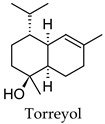
|
||
| Aniseed | 13 | 18 |
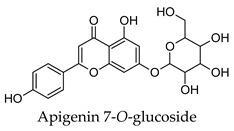
|
||
| Basil | 5 | 50 |
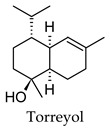
|
||
| Bay leaves | 5 | 41; 22 |
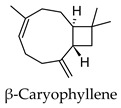
|

|
|
| Black pepper | 9 | 36; 24 |
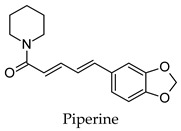
|

|
|
| Clove | 6 | 21; 20 |

|
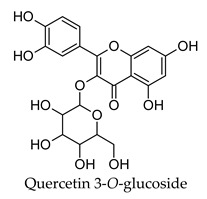
|
|
| Cumin | 13 | 10 |
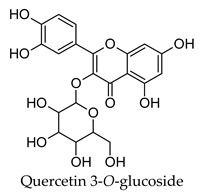
|
||
| Dill | 17 | 10; 10 |
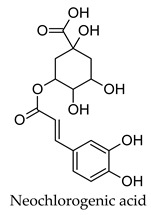
|
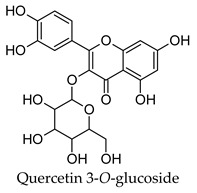
|
|
| Fennel | 6 | 52 |
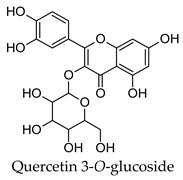
|
||
| Fenugreek | 11 | 23; 15 |
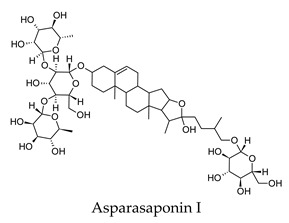
|

|
|
| Ginger | 8 | 51; 20 |
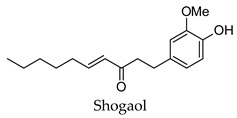
|
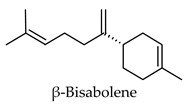
|
|
| Hops | 18 | 19; 11 |
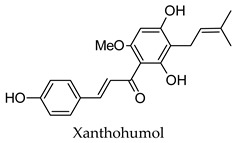
|
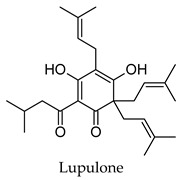
|
|
| Lemon balm | 13 | 14; 12 |
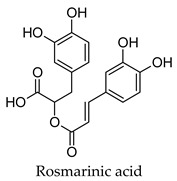
|
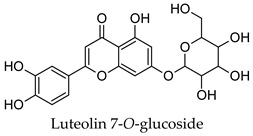
|
|
| Lemongrass | 6 | 22; 19 |
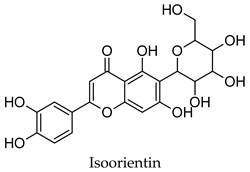
|

|
|
| Liquorice | 12 | 53; 36; 30 |
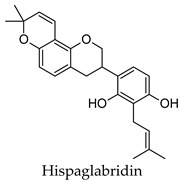
|
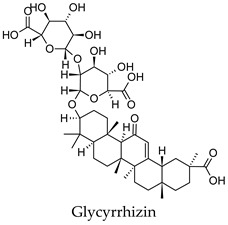
|

|
| Parsley | 7 | 11; 10 |
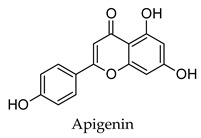
|
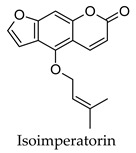
|
|
| Rosemary | 20 | 28 |
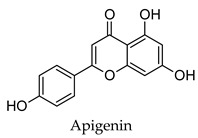
|
||
| Saffron | 5 | 27 |

|
||
| Sage | 5 | 39; 21 |
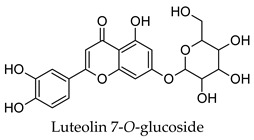
|
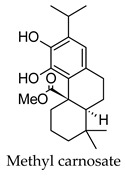
|
|
| Thyme | 13 | 22; 21 |
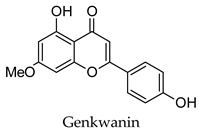
|

|
|
| Turmeric | 25 | 25; 15 |

|
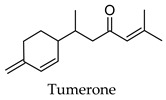
|
|
| Yarrow | 10 | 16 |
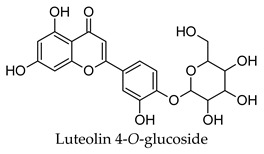
|
||
3. Materials and Methods
3.1. Literature Review
The literature review on the anti-diabetic activity of the herbs and spices was conducted with Google Scholar [261] and ScienceDirect [262] using the following search terms: “common plant name” such as fenugreek, liquorice or sage, and so forth or “scientific plant name” such as Trigonella foenum-graecum, Glycyrrhiza glabra or Salvia officinalis, and so forth, together with “anti-diabetic” or “diabetes” or “individual protein target” such as alpha-glucosidase, alpha-amylase or PPAR, and so forth. To build the compound library for virtual screening, the search terms of “common plant name” or “scientific plant name” together with “bioactive compounds”, “liquid chromatography”, “mass-spectrometry”, “gas chromatography”, “phenolic compounds” or “essential oil”, were used. The FooDB was also consulted [263].
3.2. Preparation of Compound Structures and Inverse Virtual Screening of Potential Anti-Diabetic Activity.
The SMILES notations of the compounds were obtained directly from PubChem [264]. When the compound was not found in PubChem the two-dimensional structure of the compounds was created with Advanced Chemistry Development (ACD)/ChemSketch freeware version 12.02, (Advanced Chemistry Development, Inc., Toronto, ON, Canada) [265] and then converted to its representative SMILES notation.
The SMILES notation of each compound was subsequently submitted to the DIA-DB webserver that employs inverse virtual screening of compounds with Autodock Vina against a given set of 18 protein targets associated with diabetes [224]. These targets were AKR1B1, DPP4, FBP1, FFAR1, GCK, HSD11B1, INSR, MGAM, PYGL, NR5A2, AMY2A, PPARA, PPARD, PPARG, PTPN9, PDK2, RXRA, and RBP4.
A cutoff docking score based on the average docking score of a set of known and/or experimental inhibitors was set to distinguish between potential active and inactive compounds (Table S1). The predicted compound-target network was generated by Cytoscape version 3.4.0 (Cytoscape Consortium, San Diego, CA, USA) [266] to explore the potential anti-diabetic mechanisms of action.
3.3. Hierarchical Clustering Analysis of the Bioactive Compounds
Hierarchical clustering analysis was performed for the bioactive compounds identified from each herb and spice with Schrödinger Canvas Suite version 3.2.013 (Schrödinger, LLC, New York, NY, USA) [267]. The molecular fingerprint was calculated from the two-dimensional structure of the compounds in the form of extended connectivity fingerprint 4 (ECFP4). From these fingerprints, hierarchical clustering analysis was performed using the metric of Tanimoto similarity and the Average cluster linkage method that clusters according to the average distance between all inter-cluster pairs.
4. Conclusions
The herbs and spices presented here were found to be rich sources of compounds with potential anti-diabetic activity through the use of the DIA-DB webserver. Over 900 compounds from the herb and spices library were found to have potential anti-diabetic activity and the two major chemical classes of bioactive compounds observed were the sesquiterpenoids and the flavonoids/ flavonoid glycosides. For majority of the herbs and spices, between 15 (paprika) and 157 (liquorice) compounds were identified as potential bioactive compounds versus the literature where the focus had been on only one to six compounds for a given herb or spice. The major anti-diabetic effects found in the literature for the herbs and spices were a reduction in hyperglycemia, reduction in hyperlipidemia, and regulation of insulin secretion and while some detailed studies exploring the anti-diabetic mechanisms of action of some of the herbs and spices could be found, for the majority presented here, however, very little was known. We found that the biological functions of the DIA-DB diabetes drug targets to be associated with glucose and lipid homeostasis as well as insulin secretion and sensitivity and that some of these targets were interconnected. Thus, through the regulation of these targets by the herb and spices compounds, we could explain the observed in vivo anti-diabetic activity of the herbs and spices. Collectively, the compounds of a particular herb or spice were observed to be potential regulators of 12 or more of the DIA-DB diabetes drug targets and in several cases more than one compound could potentially regulate a particular protein target, while in some cases one compound could potentially regulate more than one protein target. Bay leaves, liquorice and thyme were found to contain compounds that could potentially regulate all 18 protein targets followed by black pepper, cumin, dill, hops and marjoram with 17 protein targets. It was found that through this multi-compound-multi-target regulation of these specific diabetes targets that the major in vivo anti-diabetic effects observed in literature for the herbs and spices could be explained. We provided new insights in to the anti-diabetic mechanisms of action of allspice, aniseed, basil, bay leaves, black pepper, caraway, cardamom, dill, fennel, lemongrass, parsley, saffron, sage, star anise, thyme, and yarrow that was poorly characterized, while supporting and building onto the established anti-diabetic mechanisms of cinnamon, clove, cumin, fenugreek, ginger, liquorice, marjoram, nutmeg, oregano, rosemary, and turmeric. Extracts prepared from these herbs and spices can thus comprehensively treat the multiple dysregulated and interconnected processes associated with diabetes.
Supplementary Materials
The following are available online, Table S1. Docking scores of known and experimental drugs. Table S2. Protein targets and source plants of potential bioactive compounds found in herbs and spices.
Author Contributions
The roles of the authors in this manuscript were as follow: conceptualization, A.S.P.P., H.P.-S., Z.A.; methodology, A.S.P.P., A.J.B.-L., J.P.-G.; software, A.S.P.P., A.J.B.-L., J.P.-G.; validation, A.S.P.P., A.J.B.-L., J.P.-G.; formal analysis, H.P.-S., Z.A.; investigation, A.S.P.P., H.P.-S., Z.A.; resources, H.P.-S., Z.A.; data curation, A.S.P.P.; writing—original draft preparation, A.S.P.P.; writing—review and editing, H.P.-S., Z.A; visualization, A.S.P.P., Z.A.; supervision, H.P.-S., Z.A.; project administration, H.P.-S., Z.A.; funding acquisition, H.P.-S., Z.A.
Funding
The National Research Foundation of South Africa provided support for the postdoctoral fellowship of Dr A.S.P. Pereira. This work has been partly funded by grants from the Spanish Ministry of Economy and Competitiveness (CTQ2017-87974-R) and by the Fundación Séneca del Centro de Coordinación de la Investigación de la Región de Murcia under Project 20988/PI/18.This research was partially supported by the supercomputing infrastructure of Poznan Supercomputing Center, by the e-infrastructure program of the Research Council of Norway, and the supercomputer center of UiT-the Arctic University of Norway. The authors also thankfully acknowledge the computer resources and the technical support provided by the Plataforma Andaluza de Bioinformática of the University of Málaga. Powered@NLHPC: This research was partially supported by the supercomputing infrastructure of the NLHPC (ECM-02).
Conflicts of Interest
The authors declare no conflict of interest.
Footnotes
Sample Availability: Not available.
References
- 1.Guo X., Li H., Xu H., Woo S., Dong H., Lu F., Lange A.J., Wu C. Glycolysis in the control of blood glucose homeostasis. Acta Pharm. Sinica B. 2012;2:358–367. doi: 10.1016/j.apsb.2012.06.002. [DOI] [Google Scholar]
- 2.Fryirs M., Barter P.J., Rye K.-A. Cholesterol metabolism and pancreatic β-cell function. Curr. Opin. Lipidol. 2009;20:159–164. doi: 10.1097/MOL.0b013e32832ac180. [DOI] [PubMed] [Google Scholar]
- 3.Meerza D., Naseem I., Ahmed J. Pharmacology of signaling pathways: In type 2 diabetes. Diabetes Metab. Syndrome Clin. Res. Rev. 2013;3:180–185. doi: 10.1016/j.dsx.2013.06.006. [DOI] [PubMed] [Google Scholar]
- 4.World Health Organization Fact Sheet. [(accessed on 10 April 2019)];2017 Nov 15; Available online: http://www.who.int/newsroom/fact-sheet/detail/diabetes.
- 5.DeFronzo R.A., Triplitt C.L., Abdul-Ghani M., Cersosimo E. Novel agents for the treatment of type 2 diabetes. Diabetes Spectrum. 2014;27:100–112. doi: 10.2337/diaspect.27.2.100. [DOI] [PMC free article] [PubMed] [Google Scholar]
- 6.Gourgari E., Wilhelm E.E., Hassanzadeh H., Aroda V.R., Shoulson I. A comprehensive review of the FDA-approved labels of diabetes drugs: Indications, safety, and emerging cardiovascular safety data. J. Diabetes Complicat. 2017;31:1719–1727. doi: 10.1016/j.jdiacomp.2017.08.005. [DOI] [PubMed] [Google Scholar]
- 7.Abo K., Fred-Jaiyesimi A., Jaiyesimi A. Ethnobotanical studies of medicinal plants used in the management of diabetes mellitus in South Western Nigeria. J. Ethnopharmacol. 2008;115:67–71. doi: 10.1016/j.jep.2007.09.005. [DOI] [PubMed] [Google Scholar]
- 8.Bahmani M., Zargaran A., Rafieian-Kopaei M., Saki K. Ethnobotanical study of medicinal plants used in the management of diabetes mellitus in the Urmia, Northwest Iran. Asian Pacific J. Tropical Med. 2014;7:S348–S354. doi: 10.1016/S1995-7645(14)60257-1. [DOI] [PubMed] [Google Scholar]
- 9.Deutschländer M., Lall N., Van De Venter M. Plant species used in the treatment of diabetes by South African traditional healers: An inventory. Pharm. Biol. 2009;47:348–365. doi: 10.1080/13880200902752959. [DOI] [Google Scholar]
- 10.Grover J., Yadav S., Vats V. Medicinal plants of India with anti-diabetic potential. J. Ethnopharmacol. 2002;81:81–100. doi: 10.1016/S0378-8741(02)00059-4. [DOI] [PubMed] [Google Scholar]
- 11.Li W., Zheng H., Bukuru J., De Kimpe N. Natural medicines used in the traditional Chinese medical system for therapy of diabetes mellitus. J. Ethnopharmacol. 2004;92:1–21. doi: 10.1016/j.jep.2003.12.031. [DOI] [PubMed] [Google Scholar]
- 12.Harlev E., Nevo E., Mirsky N., Ofir R. Antidiabetic attributes of desert and steppic plants: A review. Planta Med. 2013;79:425–436. doi: 10.1055/s-0032-1328331. [DOI] [PubMed] [Google Scholar]
- 13.Moradi B., Abbaszadeh S., Shahsavari S., Alizadeh M., Beyranvand F. The most useful medicinal herbs to treat diabetes. Biomed. Res. Therapy. 2018;5:2538–2551. doi: 10.15419/bmrat.v5i8.463. [DOI] [Google Scholar]
- 14.Chen J., Mangelinckx S., Adams A., Wang Z.-t., Li W.-l., De Kimpe N. Natural flavonoids as potential herbal medication for the treatment of diabetes mellitus and its complications. Nat. Prod. Commun. 2015;10:187–200. doi: 10.1177/1934578X1501000140. [DOI] [PubMed] [Google Scholar]
- 15.Gaikwad S., Krishna Mohan G., Sandhya Rani M. Phytochemicals for diabetes management. Pharm. Crops. 2014;5:11–28. doi: 10.2174/2210290601405010011. [DOI] [Google Scholar]
- 16.Putta S., Sastry Yarla N., Kumar Kilari E., Surekha C., Aliev G., Basavaraju Divakara M., Sridhar Santosh M., Ramu R., Zameer F., Prasad M. Therapeutic potentials of triterpenes in diabetes and its associated complications. Curr. Topics Med. Chem. 2016;16:2532–2542. doi: 10.2174/1568026616666160414123343. [DOI] [PubMed] [Google Scholar]
- 17.Zheng Y., Bai L., Zhou Y., Tong R., Zeng M., Shi J., Lib X. Polysaccharides from Chinese herbal medicine for anti-diabetes recent advances. Int. J. Biol. Macromol. 2019;121:1240–1253. doi: 10.1016/j.ijbiomac.2018.10.072. [DOI] [PubMed] [Google Scholar]
- 18.Embuscado M.E. Spices and herbs: Natural sources of antioxidants–a mini review. J. Funct. Foods. 2015;18:811–819. doi: 10.1016/j.jff.2015.03.005. [DOI] [Google Scholar]
- 19.Iriti M., Vitalini S., Fico G., Faoro F. Neuroprotective herbs and foods from different traditional medicines and diets. Molecules. 2010;15:3517–3555. doi: 10.3390/molecules15053517. [DOI] [PMC free article] [PubMed] [Google Scholar]
- 20.Jungbauer A., Medjakovic S. Anti-inflammatory properties of culinary herbs and spices that ameliorate the effects of metabolic syndrome. Maturitas. 2012;71:227–239. doi: 10.1016/j.maturitas.2011.12.009. [DOI] [PubMed] [Google Scholar]
- 21.Kaefer C.M., Milner J.A. The role of herbs and spices in cancer prevention. J. Nutr. Biochem. 2008;19:347–361. doi: 10.1016/j.jnutbio.2007.11.003. [DOI] [PMC free article] [PubMed] [Google Scholar]
- 22.Tajkarimi M., Ibrahim S.A., Cliver D. Antimicrobial herb and spice compounds in food. Food Control. 2010;21:1199–1218. doi: 10.1016/j.foodcont.2010.02.003. [DOI] [Google Scholar]
- 23.Tapsell L.C., Hemphill I., Cobiac L., Sullivan D.R., Fenech M., Patch C.S., Roodenrys S., Keogh J.B., Clifton P.M., Williams P.G. Health benefits of herbs and spices: The past, the present, the future. [(accessed on 23 September 2019)]; doi: 10.5694/j.1326-5377.2006.tb00548.x. Available online: https://ro.uow.edu.au/hbspapers/28/ [DOI] [PubMed]
- 24.Chen B.-W., Li W.-X., Wang G.-H., Li G.-H., Liu J.-Q., Zheng J.-J., Wang Q., Li H.-J., Dai S.-X., Huang J.-F. A strategy to find novel candidate anti-Alzheimer’s disease drugs by constructing interaction networks between drug targets and natural compounds in medical plants. PeerJ. 2018;6:e4756. doi: 10.7717/peerj.4756. [DOI] [PMC free article] [PubMed] [Google Scholar]
- 25.Dai S.-X., Li W.-X., Han F.-F., Guo Y.-C., Zheng J.-J., Liu J.-Q., Wang Q., Gao Y.-D., Li G.-H., Huang J.-F. In silico identification of anti-cancer compounds and plants from traditional Chinese medicine database. Sci. Rep. 2016;6:25462. doi: 10.1038/srep25462. [DOI] [PMC free article] [PubMed] [Google Scholar]
- 26.Liu J.-Q., Dai S.-X., Zheng J.-J., Guo Y.-C., Li W.-X., Li G.-H., Huang J.-F. The identification and molecular mechanism of anti-stroke traditional Chinese medicinal compounds. Sci. Rep. 2017;7:41406. doi: 10.1038/srep41406. [DOI] [PMC free article] [PubMed] [Google Scholar]
- 27.Broadhurst C.L., Polansky M.M., Anderson R.A. Insulin-like biological activity of culinary and medicinal plant aqueous extracts in vitro. J. Agric. Food Chem. 2000;48:849–852. doi: 10.1021/jf9904517. [DOI] [PubMed] [Google Scholar]
- 28.Loizzo M.R., Sicari V., Tenuta M.C., Leporini M.R., Falco T., Pellicanò T.M., Menichini F., Tundis R. Phytochemicals content, antioxidant and hypoglycaemic activities of commercial nutmeg mace (Myristica fragrans L.) and pimento (Pimenta dioica (L.) Merr.) Int. J. Food Sci. Technol. 2016;51:2057–2063. doi: 10.1111/ijfs.13178. [DOI] [Google Scholar]
- 29.Yogalakshmi K., Vaidehi J. Free radical scavenging activity of methanolic leaf extract of Pimenta dioica on streptozotocin-induced diabetic rats. [(accessed on 1 August 2019)]; Available online: http://www.jipbs.com/VolumeArticles/FullTextPDF/119_JIPBSV2I404.pdf.
- 30.Shobha R., Rajeshwari C., Andallu B. Anti-peroxidative and anti-diabetic activities of aniseeds (Pimpinella anisum L.) and identification of bioactive compounds. Amer. J. Phytomed. Clin. Therap. 2013;1:516–527. [Google Scholar]
- 31.Farzaneh V., Gominho J., Pereira H., Carvalho I.S. Screening of the Antioxidant and Enzyme Inhibition Potentials of Portuguese Pimpinella anisum L. Seeds by GC-MS. Food Analy. Methods. 2018;11:2645–2656. doi: 10.1007/s12161-018-1250-x. [DOI] [Google Scholar]
- 32.Shobha R.I., Andallu B. Antioxidant, Anti-Diabetic and Hypolipidemic Effects of Aniseeds (Pimpinella anisum L.): In vitro and in vivo Studies. J. Complement Med. Alt. Healthcare. 2018;5:1–12. [Google Scholar]
- 33.El-Beshbishy H., Bahashwan S. Hypoglycemic effect of basil (Ocimum basilicum) aqueous extract is mediated through inhibition of α-glucosidase and α-amylase activities: An in vitro study. Toxicol. Ind. Health. 2012;28:42–50. doi: 10.1177/0748233711403193. [DOI] [PubMed] [Google Scholar]
- 34.Bhatti H.A., Tehseen Y., Maryam K., Uroos M., Siddiqui B.S., Hameed A., Iqbal J. Identification of new potent inhibitor of aldose reductase from Ocimum basilicum. Bioorganic Chem. 2017;75:62–70. doi: 10.1016/j.bioorg.2017.08.011. [DOI] [PubMed] [Google Scholar]
- 35.Ademiluyi A.O., Oyeleye S.I., Oboh G. Biological activities, antioxidant properties and phytoconstituents of essential oil from sweet basil (Ocimum basilicum L.) leaves. Comparative Clin. Pathol. 2016;25:169–176. doi: 10.1007/s00580-015-2163-3. [DOI] [Google Scholar]
- 36.Ezeani C., Ezenyi I., Okoye T., Okoli C. Ocimum basilicum extract exhibits antidiabetic effects via inhibition of hepatic glucose mobilization and carbohydrate metabolizing enzymes. J. Int. Ethnopharmacol. 2017;6:22. doi: 10.5455/jice.20161229054825. [DOI] [PMC free article] [PubMed] [Google Scholar]
- 37.Irondi E.A., Agboola S.O., Oboh G., Boligon A.A. Inhibitory effect of leaves extracts of Ocimum basilicum and Ocimum gratissimum on two key enzymes involved in obesity and hypertension in vitro. J. Int. Ethnopharmacol. 2016;5:396. doi: 10.5455/jice.20160814112756. [DOI] [PMC free article] [PubMed] [Google Scholar]
- 38.Kadan S., Saad B., Sasson Y., Zaid H. In vitro evaluation of anti-diabetic activity and cytotoxicity of chemically analysed Ocimum basilicum extracts. Food Chem. 2016;196:1066–1074. doi: 10.1016/j.foodchem.2015.10.044. [DOI] [PubMed] [Google Scholar]
- 39.Malapermal V., Botha I., Krishna S.B.N., Mbatha J.N. Enhancing antidiabetic and antimicrobial performance of Ocimum basilicum, and Ocimum sanctum (L.) using silver nanoparticles. Saudi J. Bio. Sci. 2017;24:1294–1305. doi: 10.1016/j.sjbs.2015.06.026. [DOI] [PMC free article] [PubMed] [Google Scholar]
- 40.Yen H.-F., Hsieh C.-T., Hsieh T.-J., Chang F.-R., Wang C.-K. In vitro anti-diabetic effect and chemical component analysis of 29 essential oils products. J. Food Drug Analy. 2015;23:124–129. doi: 10.1016/j.jfda.2014.02.004. [DOI] [PMC free article] [PubMed] [Google Scholar]
- 41.Ugwu M., Umar I., Utu-Baku A., Dasofunjo K., Ukpanukpong R., Yakubu O., Okafor A. Antioxidant status and organ function in streptozotocin-induced diabetic rats treated with aqueous, methanolic and petroleum ether extracts of Ocimum basilicum leaf. J. Appl. Pharm. Sci. 2013;3:S75–S79. [Google Scholar]
- 42.Saraswat M., Muthenna P., Suryanarayana P., Petrash J.M., Reddy G.B. Dietary sources of aldose reductase inhibitors: Prospects for alleviating diabetic complications. Asia Pacific J. Clin. Nutri. 2008;17:55–564. [PubMed] [Google Scholar]
- 43.Basak S.S., Candan F. Effect of Laurus nobilis L. essential oil and its main components on α-glucosidase and reactive oxygen species scavenging activity. Iranian J. Pharm. Res. IJPR. 2013;12:367–379. [PMC free article] [PubMed] [Google Scholar]
- 44.Aljamal A. Effect bay leaves on the patients with diabetes mellitus. Res. J. Med. Plants. 2011;5:471–476. doi: 10.3923/rjmp.2011.471.476. [DOI] [Google Scholar]
- 45.Khan A., Zaman G., Anderson R.A. Bay leaves improve glucose and lipid profile of people with type 2 diabetes. J. Clin. Biochem. Nutri. 2009;44:52–56. doi: 10.3164/jcbn.08-188. [DOI] [PMC free article] [PubMed] [Google Scholar]
- 46.Gupta S., Singh N., Jaggi A.S. Evaluation of in vitro aldose reductase inhibitory potential of alkaloidal fractions of Piper nigrum, Murraya koenigii, Argemone mexicana, and Nelumbo nucifera. J. Basic Clin. Physiol. Pharmacol. 2014;25:255–265. doi: 10.1515/jbcpp-2013-0071. [DOI] [PubMed] [Google Scholar]
- 47.Kavitha S., Rameshkannan D.M., Mani D.P. Analysis of antioxidant and antidiabetic activity of Piper nigrum leaf extract by in-vitro assay. J. Pharm. Bio. Sci. 2018;13:53–56. [Google Scholar]
- 48.Oboh G., Ademosun A.O., Odubanjo O.V., Akinbola I.A. Antioxidative properties and inhibition of key enzymes relevant to type-2 diabetes and hypertension by essential oils from black pepper. Adv. Pharm. Sci. 2013;2013:1–6. doi: 10.1155/2013/926047. [DOI] [PMC free article] [PubMed] [Google Scholar]
- 49.Mueller M., Beck V., Jungbauer A. PPARα activation by culinary herbs and spices. Planta Medica. 2011;77:497–504. doi: 10.1055/s-0030-1250435. [DOI] [PubMed] [Google Scholar]
- 50.Atal S., Agrawal R.P., Vyas S., Phadnis P., Rai N. Evaluation of the effect of piperine per se on blood glucose level in alloxan-induced diabetic mice. Acta Pol. Pharm. 2012;69:965–969. [PubMed] [Google Scholar]
- 51.Onyesife C.O., Ogugua V.N., Anaduaka E.G. Hypoglycemic potentials of ethanol leaves extract of black pepper (Piper nigrum) on alloxan-induced diabetic rats. Annals Biol. Res. 2014;5:26–31. [Google Scholar]
- 52.Kaleem M., Sheema S.H., Bano B. Protective effects of Piper nigrum and Vinca rosea in alloxan induced diabetic rats. Indian J. Physiol. Pharmacol. 2005;49:65–71. [PubMed] [Google Scholar]
- 53.Sarfraz M., Khaliq T., Khan J.A., Aslam B. Effect of aqueous extract of black pepper and ajwa seed on liver enzymes in alloxan-induced diabetic Wister albino rats. Saudi Pharm. J. 2017;25:449–452. doi: 10.1016/j.jsps.2017.04.004. [DOI] [PMC free article] [PubMed] [Google Scholar]
- 54.Veeresham C., Sujatha S., Rani T.S. Effect of piperine on the pharmacokinetics and pharmacodynamics of glimepiride in normal and streptozotocin-induced diabetic rats. Nat. Prod. Commun. 2012;7:1283–1286. doi: 10.1177/1934578X1200701009. [DOI] [PubMed] [Google Scholar]
- 55.Eidi A., Eidi M., Haeri Rohani A., Basati F. Hypoglycemic effect of ethanolic extract of Carum carvi L. seeds in normal and streptozotocin-induced diabetic rats. J. Med. Plants. 2010;9:106–113. [Google Scholar]
- 56.Ene A., Nwankwo E., Samdi L. Alloxan-induced diabetes in rats and the effects of Black caraway (Carum carvi L.) oil on their body weights. J. Pharmacol. Toxicol. 2008;3:141–146. [Google Scholar]
- 57.Erjaee H., Rajaian H., Nazifi S., Chahardahcherik M. The effect of caraway (Carum carvi L.) on the blood antioxidant enzymes and lipid peroxidation in streptozotocin-induced diabetic rats. Comparative Clin. Pathol. 2015;24:1197–1203. doi: 10.1007/s00580-014-2060-1. [DOI] [Google Scholar]
- 58.Haidari F., Seyed-Sadjadi N., Taha-Jalali M., Mohammed-Shahi M. The effect of oral administration of Carum carvi on weight, serum glucose, and lipid profile in streptozotocin-induced diabetic rats. Saudi Med. J. 2011;32:695–700. [PubMed] [Google Scholar]
- 59.Lemhadri A., Hajji L., Michel J.-B., Eddouks M. Cholesterol and triglycerides lowering activities of caraway fruits in normal and streptozotocin diabetic rats. J. Ethnopharmacol. 2006;106:321–326. doi: 10.1016/j.jep.2006.01.033. [DOI] [PubMed] [Google Scholar]
- 60.El-Yamani M. Cinnamon, cardamom and ginger impacts as evaluated on hyperglycemic rats. Res. J. Specific Educ. 2011;20:665–678. [Google Scholar]
- 61.Winarsi H., Sasongko N., Purwanto A., Nuraeni I. Effect of cardamom leaves extract as antidiabetic, weight lost and hypocholesterolemic to alloxan-induced Sprague Dawley diabetic rats. Int. Food Res. J. 2014;21:2253–2261. [Google Scholar]
- 62.Bhat G.N., Nayak N., Vinodraj K., Chandralekha N., Mathai P., Cherian J. Comparison of the efficacy of cardamom (Elettaria cardamomum) with pioglitazone on dexamethasone-induced hepatic steatosis, dyslipidemia, and hyperglycemia in albino rats. J. Adv. Pharm. Technol. Res. 2015;6:136–140. doi: 10.4103/2231-4040.157981. [DOI] [PMC free article] [PubMed] [Google Scholar]
- 63.Bhaswant M., Poudyal H., Mathai M., Ward L., Mouatt P., Brown L. Green and black cardamom in a diet-induced rat model of metabolic syndrome. Nutrients. 2015;7:7691–7707. doi: 10.3390/nu7095360. [DOI] [PMC free article] [PubMed] [Google Scholar]
- 64.Gholamhoseinian A., Fallah H., Sharifi-far F., Mirtajaddini M. The inhibitory effect of some Iranian plants extracts on the alpha glucosidase. Iranian J. Basic Med. Sci. 2008;11:1–9. [Google Scholar]
- 65.Hamza A., Ksiksi T., Shamsi O., Balfaqh S. α-Glucosidase Inhibitory Activity of Common Traditional Medicinal Plants Used for Diabetes Mellitus. J. Dev. Drugs. 2015;4:1–5. doi: 10.4172/2329-6631.1000144. [DOI] [Google Scholar]
- 66.Medagama A.B. The glycaemic outcomes of Cinnamon, a review of the experimental evidence and clinical trials. Nutri. J. 2015;14:108. doi: 10.1186/s12937-015-0098-9. [DOI] [PMC free article] [PubMed] [Google Scholar]
- 67.Ponnusamy S., Ravindran R., Zinjarde S., Bhargava S., Ravi Kumar A. Evaluation of traditional Indian antidiabetic medicinal plants for human pancreatic amylase inhibitory effect in vitro. Evid. Based Complemen. Alter. Med. 2011;2011:1–10. doi: 10.1155/2011/515647. [DOI] [PMC free article] [PubMed] [Google Scholar]
- 68.Seetaloo A., Aumeeruddy M., Kannan R.R., Mahomoodally M. Potential of traditionally consumed medicinal herbs, spices, and food plants to inhibit key digestive enzymes geared towards diabetes mellitus management—A systematic review. South African J. Botany. 2019;120:3–24. doi: 10.1016/j.sajb.2018.05.015. [DOI] [Google Scholar]
- 69.Salehi P., Asghari B., Esmaeili M.A., Dehghan H., Ghazi I. α-Glucosidase and α-amylase inhibitory effect and antioxidant activity of ten plant extracts traditionally used in Iran for diabetes. J. Med. Plants Res. 2013;7:257–266. [Google Scholar]
- 70.Tahir H.U., Sarfraz R.A., Ashraf A., Adil S. Chemical composition and antidiabetic Activity of essential oils obtained from two spices (Syzygium aromaticum and Cuminum cyminum) Int. J. Food Propert. 2016;19:2156–2164. doi: 10.1080/10942912.2015.1110166. [DOI] [Google Scholar]
- 71.Adefegha S.A., Oboh G. Inhibition of key enzymes linked to type 2 diabetes and sodium nitroprusside-induced lipid peroxidation in rat pancreas by water extractable phytochemicals from some tropical spices. Pharm. Biol. 2012;50:857–865. doi: 10.3109/13880209.2011.641022. [DOI] [PubMed] [Google Scholar]
- 72.Adefegha S.A., Oboh G. In vitro inhibition activity of polyphenol-rich extracts from Syzygium aromaticum (L.) Merr. & Perry (Clove) buds against carbohydrate hydrolyzing enzymes linked to type 2 diabetes and Fe2+-induced lipid peroxidation in rat pancreas. Asian Pacific J. Tropical Biomed. 2012;2:774–781. doi: 10.1016/S2221-1691(12)60228-7. [DOI] [PMC free article] [PubMed] [Google Scholar]
- 73.Prasad R.C., Herzog B., Boone B., Sims L., Waltner-Law M. An extract of Syzygium aromaticum represses genes encoding hepatic gluconeogenic enzymes. J. Ethnopharmacol. 2005;96:295–301. doi: 10.1016/j.jep.2004.09.024. [DOI] [PubMed] [Google Scholar]
- 74.Kuroda M., Mimaki Y., Ohtomo T., Yamada J., Nishiyama T., Mae T., Kishida H., Kawada T. Hypoglycemic effects of clove (Syzygium aromaticum flower buds) on genetically diabetic KK-A y mice and identification of the active ingredients. J. Nat. Med. 2012;66:394–399. doi: 10.1007/s11418-011-0593-z. [DOI] [PubMed] [Google Scholar]
- 75.Al-Attar A.M., Zari T.A. Modulatory effects of ginger and clove oils on physiological responses in streptozotocin-induced diabetic rats. Int. J. Pharmacol. 2007;3:34–40. [Google Scholar]
- 76.Khathi A., Serumula M.R., Myburg R.B., Van Heerden F.R., Musabayane C.T. Effects of Syzygium aromaticum-derived triterpenes on postprandial blood glucose in streptozotocin-induced diabetic rats following carbohydrate challenge. PLoS ONE. 2013;8:e81632. doi: 10.1371/journal.pone.0081632. [DOI] [PMC free article] [PubMed] [Google Scholar]
- 77.Mkhwanazi B.N., Serumula M.R., Myburg R.B., Van Heerden F.R., Musabayane C.T. Antioxidant effects of maslinic acid in livers, hearts and kidneys of streptozotocin-induced diabetic rats: Effects on kidney function. Renal Failure. 2014;36:419–431. doi: 10.3109/0886022X.2013.867799. [DOI] [PubMed] [Google Scholar]
- 78.Ngubane P.S., Masola B., Musabayane C.T. The effects of Syzygium aromaticum-derived oleanolic acid on glycogenic enzymes in streptozotocin-induced diabetic rats. Renal Failure. 2011;33:434–439. doi: 10.3109/0886022X.2011.568147. [DOI] [PubMed] [Google Scholar]
- 79.Adefegha S.A., Oboh G., Adefegha O.M., Boligon A.A., Athayde M.L. Antihyperglycemic, hypolipidemic, hepatoprotective and antioxidative effects of dietary clove (Szyzgium aromaticum) bud powder in a high-fat diet/streptozotocin-induced diabetes rat model. J. Sci. Food Agric. 2014;94:2726–2737. doi: 10.1002/jsfa.6617. [DOI] [PubMed] [Google Scholar]
- 80.Ranilla L.G., Kwon Y.-I., Apostolidis E., Shetty K. Phenolic compounds, antioxidant activity and in vitro inhibitory potential against key enzymes relevant for hyperglycemia and hypertension of commonly used medicinal plants, herbs and spices in Latin America. Bioresource Technol. 2010;101:4676–4689. doi: 10.1016/j.biortech.2010.01.093. [DOI] [PubMed] [Google Scholar]
- 81.Hemlata B., Pornima G., Tukaram K., Pankaj B. In vitro anti-amylase activity of some Indian dietary spices. J. Appl. Biol. Biotechnol. Vol. 2019;7:70–74. [Google Scholar]
- 82.Lee H.-S. Cuminaldehyde: Aldose reductase and α-glucosidase inhibitor derived from Cuminum cyminum L. seeds. J. Agric. Food Chem. 2005;53:2446–2450. doi: 10.1021/jf048451g. [DOI] [PubMed] [Google Scholar]
- 83.Srivsatava R., Srivastava S.P., Jaiswal N., Mishra A., Maurya R., Srivastava A.K. Antidiabetic and antidyslipidemic activities of Cuminum cyminum L. in validated animal models. Med. Chem. Res. 2011;20:1656–1666. doi: 10.1007/s00044-010-9483-2. [DOI] [Google Scholar]
- 84.Rau O., Wurglics M., Dingermann T., Abdel-Tawab M., Schubert-Zsilavecz M. Screening of herbal extracts for activation of the human peroxisome proliferator-activated receptor. Die Pharmazie An Int. J. Pharm. Sci. 2006;61:952–956. [PubMed] [Google Scholar]
- 85.Jagtap A., Patil P. Antihyperglycemic activity and inhibition of advanced glycation end product formation by Cuminum cyminum in streptozotocin induced diabetic rats. Food Chem. Toxicol. 2010;48:2030–2036. doi: 10.1016/j.fct.2010.04.048. [DOI] [PubMed] [Google Scholar]
- 86.Bahrami E., Khedri M.R., Zangeneh M.M., Abiari M., Zangeneh A., Amiri-Paryan A., Tahvilian R., Moradi R. Effect of Anethum graveolens aqueous extract on blood fasting glucose and hematological parameters in diabetic male BALB/c mice. Onl. J. Vet. Res. 2017;21:784–793. [Google Scholar]
- 87.Goodarzi M.T., Khodadadi I., Tavilani H., Abbasi Oshaghi E. The role of Anethum graveolens L. (Dill) in the management of diabetes. J. Tropical Med. 2016;2016:1–11. doi: 10.1155/2016/1098916. [DOI] [PMC free article] [PubMed] [Google Scholar]
- 88.Mishra N. Haematological and hypoglycemic potential Anethum graveolens seeds extract in normal and diabetic Swiss albino mice. Veterinary World. 2013;6:502–507. doi: 10.5455/vetworld.2013.502-507. [DOI] [Google Scholar]
- 89.Oshaghi E.A., Tavilani H., Khodadadi I., Goodarzi M.T. Dill tablet: A potential antioxidant and anti-diabetic medicine. Asian Pacific J. Tropical Biomed. 2015;5:720–727. doi: 10.1016/j.apjtb.2015.06.012. [DOI] [Google Scholar]
- 90.Abu-Zaiton A., Alu’datt M., Wafa M. Evaluating the effect of Foeniculum vulgare extract on enzymes related with blood pressure and diabetes (in vitro study) Int. J. Chem. Eng. Biol. Sci. 2015;2:77–80. [Google Scholar]
- 91.Godavari A., Amutha K., Moorthi N.M. In-vitro hypoglycemic effect of Foeniculum vulgare Mill. Seeds on the carbohydrate hydrolysing enzymes, alpha-amylase and alpha-glucosidase. Int. J. Pharm. Sci. Res. 2018;9:4441–4445. [Google Scholar]
- 92.Al-Aridhi D.T. The Effect of Foeniculum Vulgare Alcoholic Extract on Some Metabolic Changes in Liver and Kidneys of Alloxan Diabetic Mice. Iraqi J. Med. Sci. 2014;12:119–125. [Google Scholar]
- 93.Anitha T., Balakumar C., Ilango K., Jose C.B., Vetrivel D. Antidiabetic activity of the aqueous extracts of Foeniculum vulgare on streptozotocin-induced diabetic rats. Int. J. Adv. Pharm. Biol. Chem. 2014;3:487–494. [Google Scholar]
- 94.El-Soud N., El-Laithy N., El-Saeed G., Wahby M., Khalil M., Morsy F., Shaffie N. Antidiabetic activities of Foeniculum vulgare Mill. essential oil in streptozotocin-induced diabetic rats. Macedonian J. Med. Sci. 2011;4:139–146. [Google Scholar]
- 95.Parsaeyan N. The effect of Foeniculum vulgare (fennel) extract on lipid profile, lipid peroxidation and liver enzymes of diabetic rat. Iranian J. Diabetes Obesity. 2016;8:24–29. [Google Scholar]
- 96.Ganeshpurkar A., Diwedi V., Bhardwaj Y. In vitro α-amylase and α-glucosidase inhibitory potential of Trigonella foenum-graecum leaves extract. Ayu. 2013;34:109–112. doi: 10.4103/0974-8520.115446. [DOI] [PMC free article] [PubMed] [Google Scholar]
- 97.Bansode T.S., Gupta A., Chaphalkar S., Salalkar B. Integrating in-silico and in-vitro approaches to screen the antidiabetic drug from Trigonella foenum graecum Linn. Int. J. Biochem. Res. Rev. 2016;14:1–10. doi: 10.9734/IJBCRR/2016/29875. [DOI] [Google Scholar]
- 98.Gad M.Z., El-Sawalhi M.M., Ismail M.F., El-Tanbouly N.D. Biochemical study of the anti-diabetic action of the Egyptian plants Fenugreek and Balanites. Mol. Cell. Biochem. 2006;281:173–183. doi: 10.1007/s11010-006-0996-4. [DOI] [PubMed] [Google Scholar]
- 99.Kamtekar S., Keer V., Patil V. Estimation of phenolic content, flavonoid content, antioxidant and alpha amylase inhibitory activity of marketed polyherbal formulation. J. Appl. Pharm. Sci. 2014;4:61–65. [Google Scholar]
- 100.Hamden K., Keskes H., Elgomdi O., Feki A., Alouche N. Modulatory effect of an isolated triglyceride from fenugreek seed oil on of α-amylase, lipase and ace activities, liver-kidney functions and metabolic disorders of diabetic rats. J. Oleo Sci. 2017;66:633–645. doi: 10.5650/jos.ess16254. [DOI] [PubMed] [Google Scholar]
- 101.Buchholz T., Melzig M.F. Medicinal plants traditionally used for treatment of obesity and diabetes mellitus–screening for pancreatic lipase and α-Amylase inhibition. Phytotherapy Res. 2016;30:260–266. doi: 10.1002/ptr.5525. [DOI] [PubMed] [Google Scholar]
- 102.Christensen K.B., Minet A., Svenstrup H., Grevsen K., Zhang H., Schrader E., Rimbach G., Wein S., Wolffram S., Kristiansen K. Identification of plant extracts with potential antidiabetic properties: Effect on human peroxisome proliferator-activated receptor (PPAR), adipocyte differentiation and insulin-stimulated glucose uptake. Phytotherapy Res. 2009;23:1316–1325. doi: 10.1002/ptr.2782. [DOI] [PubMed] [Google Scholar]
- 103.Hamden K., Jaouadi B., Carreau S., Bejar S., Elfeki A. Inhibitory effect of fenugreek galactomannan on digestive enzymes related to diabetes, hyperlipidemia, and liver-kidney dysfunctions. Biotechnol. Bioproc. Eng. 2010;15:407–413. doi: 10.1007/s12257-009-3037-9. [DOI] [Google Scholar]
- 104.Hamden K., Jaouadi B., Salami T., Carreau S., Bejar S., Elfeki A. Modulatory effect of fenugreek saponins on the activities of intestinal and hepatic disaccharidase and glycogen and liver function of diabetic rats. Biotechnol. Bioproc. Eng. 2010;15:745–753. doi: 10.1007/s12257-009-3159-0. [DOI] [Google Scholar]
- 105.Hamden K., Keskes H., Belhaj S., Mnafgui K., Allouche N. Inhibitory potential of omega-3 fatty and fenugreek essential oil on key enzymes of carbohydrate-digestion and hypertension in diabetes rats. Lipids Health Disease. 2011;10:1–10. doi: 10.1186/1476-511X-10-226. [DOI] [PMC free article] [PubMed] [Google Scholar]
- 106.Tharaheswari M., Kumar J.S.P., Reddy N.J., Subhashree S., Rani S.S. Fenugreek seed extract stabilize plasma lipid levels in type 2 diabetes by modulating PPARs and GLUT4 in insulin target tissues. AJPCT. 2014;2:587–602. [Google Scholar]
- 107.Alu’datt M.H., Rababah T., Alhamad M.N., Gammoh S., Ereifej K., Johargy A., Kubow S., Almajwal A.M., Rawashdeh M. Optimization of Phenolic Content, Antioxidant, and Inhibitory Activities of α-Glucosidase and Angiotensin Converting (AC) Enzymes from Zingiber officinale Z. Int. J. Food Propert. 2016;19:1303–1316. doi: 10.1080/10942912.2015.1063066. [DOI] [Google Scholar]
- 108.Elya B., Handayani R., Sauriasari R., Hasyyati U.S., Permana I.T., Permatasari Y.I. Antidiabetic activity and phytochemical screening of extracts from Indonesian plants by inhibition of alpha amylase, alpha glucosidase and dipeptidyl peptidase IV. Pakistan J. Bio. Sci. 2015;18:279–284. doi: 10.3923/pjbs.2015.279.284. [DOI] [Google Scholar]
- 109.Adefegha A. Inhibitory effects of aqueous extract of two varieties of ginger on some key enzymes linked to type-2 diabetes in vitro. J. Food Nutri. Res. 2010;49:14–20. [Google Scholar]
- 110.Priya Rani M., Padmakumari K., Sankarikutty B., Lijo Cherian O., Nisha V., Raghu K. Inhibitory potential of ginger extracts against enzymes linked to type 2 diabetes, inflammation and induced oxidative stress. Int. J. Food Sci. Nutri. 2011;62:106–110. doi: 10.3109/09637486.2010.515565. [DOI] [PubMed] [Google Scholar]
- 111.Kato A., Higuchi Y., Goto H., Kizu H., Okamoto T., Asano N., Hollinshead J., Nash R.J., Adachi I. Inhibitory effects of Zingiber officinale Roscoe derived components on aldose reductase activity in vitro and in vivo. J. Agric. Food Chem. 2006;54:6640–6644. doi: 10.1021/jf061599a. [DOI] [PubMed] [Google Scholar]
- 112.Son M.J., Miura Y., Yagasaki K. Mechanisms for antidiabetic effect of gingerol in cultured cells and obese diabetic model mice. Cytotechnology. 2015;67:641–652. doi: 10.1007/s10616-014-9730-3. [DOI] [PMC free article] [PubMed] [Google Scholar]
- 113.Keskin Ş., Şirin Y., Çakir H., Keskin M. An investigation of Humulus lupulus L.: Phenolic composition, antioxidant capacity and inhibition properties of clinically important enzymes. South African J. Botany. 2019;120:170–174. doi: 10.1016/j.sajb.2018.04.017. [DOI] [Google Scholar]
- 114.Seliger J.M., Misuri L., Maser E., Hintzpeter J. The hop-derived compounds xanthohumol, isoxanthohumol and 8-prenylnaringenin are tight-binding inhibitors of human aldo-keto reductases 1B1 and 1B10. J. Enzyme Inhibit. Med. Chem. 2018;33:607–614. doi: 10.1080/14756366.2018.1437728. [DOI] [PMC free article] [PubMed] [Google Scholar]
- 115.Liu M., Yin H., Liu G., Dong J., Qian Z., Miao J. Xanthohumol, a prenylated chalcone from beer hops, acts as an α-glucosidase inhibitor in vitro. J. Agric. Food Chem. 2014;62:5548–5554. doi: 10.1021/jf500426z. [DOI] [PubMed] [Google Scholar]
- 116.Lima-Fontes M.r., Costa R., Rodrigues I., Soares R. Xanthohumol restores hepatic glucolipid metabolism balance in type 1 diabetic wistar rats. J. Agric. Food Chem. 2017;65:7433–7439. doi: 10.1021/acs.jafc.7b02595. [DOI] [PubMed] [Google Scholar]
- 117.Sun H., Wang D., Song X., Zhang Y., Ding W., Peng X., Zhang X., Li Y., Ma Y., Wang R. Natural prenylchalconaringenins and prenylnaringenins as antidiabetic agents: α-glucosidase and α-amylase inhibition and in vivo antihyperglycemic and antihyperlipidemic effects. J. Agric. Food Chem. 2017;65:1574–1581. doi: 10.1021/acs.jafc.6b05445. [DOI] [PubMed] [Google Scholar]
- 118.Yajima H., Ikeshima E., Shiraki M., Kanaya T., Fujiwara D., Odai H., Tsuboyama-Kasaoka N., Ezaki O., Oikawa S., Kondo K. Isohumulones, bitter acids derived from hops, activate both peroxisome proliferator-activated receptor α and γ and reduce insulin resistance. J. Bio. Chem. 2004;279:33456–33462. doi: 10.1074/jbc.M403456200. [DOI] [PubMed] [Google Scholar]
- 119.Nozawa H. Xanthohumol, the chalcone from beer hops (Humulus lupulus L.), is the ligand for farnesoid X receptor and ameliorates lipid and glucose metabolism in KK-Ay mice. Biochem. Biophys. Res. Commun. 2005;336:754–761. doi: 10.1016/j.bbrc.2005.08.159. [DOI] [PubMed] [Google Scholar]
- 120.Takahashi K., Osada K. Effect of dietary purified xanthohumol from hop (Humulus lupulus L.) pomace on adipose tissue mass, fasting blood glucose level, and lipid metabolism in KK-Ay mice. J. Oleo Sci. 2017;66:531–541. doi: 10.5650/jos.ess16234. [DOI] [PubMed] [Google Scholar]
- 121.Kwon Y.-I.I., Vattem D.A., Shetty K. Evaluation of clonal herbs of Lamiaceae species for management of diabetes and hypertension. Asia Pacific J. Clin. Nutri. 2006;15:107–118. [PubMed] [Google Scholar]
- 122.Weidner C., Wowro S.J., Freiwald A., Kodelja V., Abdel-Aziz H., Kelber O., Sauer S. Lemon balm extract causes potent antihyperglycemic and antihyperlipidemic effects in insulin-resistant obese mice. Mol. Nutri. Food Res. 2014;58:903–907. doi: 10.1002/mnfr.201300477. [DOI] [PubMed] [Google Scholar]
- 123.Hasanein P., Riahi H. Antinociceptive and antihyperglycemic effects of Melissa officinalis essential oil in an experimental model of diabetes. Med. Prin. Practice. 2015;24:47–52. doi: 10.1159/000368755. [DOI] [PMC free article] [PubMed] [Google Scholar]
- 124.Khodsooz S., Moshtaghian J., Eivani M. Antihyperglycemic and antihyperlipidemic effects of hydroalcoholic extract of Melissa officinalis (Lemon Balm) in alloxan-induced diabetic rats. Physiol. Pharmacol. 2016;20:24–30. [Google Scholar]
- 125.Tashakor A., Kelishadi M.R., Ghasemi A., Daylami F., Rahimi A., Doabi S.Z., Abdolusefi N.N. Effects of hydroalcoholic extract in Mellissa officinalis plant on fat profiles and glucose level in diabetic rats induced by streptozotocin. J. Chem. Pharm. Res. 2016;8:402–406. [Google Scholar]
- 126.Boaduo N.K.K., Katerere D., Eloff J.N., Naidoo V. Evaluation of six plant species used traditionally in the treatment and control of diabetes mellitus in South Africa using in vitro methods. Pharm. Biol. 2014;52:756–761. doi: 10.3109/13880209.2013.869828. [DOI] [PubMed] [Google Scholar]
- 127.Jagdale A.D., Kamble S.P., Nalawade M.L., Arvindekar A.U. Citronellol: A potential antioxidant and aldose reductase inhibitor from Cymbopogon citratus. Int. J. Pharm. Pharm. Sci. 2015;7:203–209. [Google Scholar]
- 128.Santoso F., Winarno J., Gunawan-Puteri M.D. Application of Lemongrass (Cymbopogon Citratus) As A Functional Food Ingredient With Alpha-Glucosidase Inhibitory Activity. Adv. Eng. Res. 2018;172:205–209. [Google Scholar]
- 129.Jumepaeng T., Prachakool S., Luthria D.L., Chanthai S. Determination of antioxidant capacity and α-amylase inhibitory activity of the essential oils from citronella grass and lemongrass. Int. Food Res. J. 2013;20:481–485. [Google Scholar]
- 130.Bharti S., Kumar A., Prakash O., Krishnan S., Gupta A. Essential oil of cymbopogon citratus against diabetes: Validation by in vivo experiments and computational studies. J Bioanal. Biomed. 2013;5:194–203. [Google Scholar]
- 131.Kuroda M., Mimaki Y., Honda S., Tanaka H., Yokota S., Mae T. Phenolics from Glycyrrhiza glabra roots and their PPAR-γ ligand-binding activity. Bioorganic Med. Chem. 2010;18:962–970. doi: 10.1016/j.bmc.2009.11.027. [DOI] [PubMed] [Google Scholar]
- 132.Ko B.-S., Jang J.S., Hong S.M., Sung S.R., Lee J.E., Lee M.Y., Jeon W.K., Park S. Changes in components, glycyrrhizin and glycyrrhetinic acid, in raw Glycyrrhiza uralensis Fisch, modify insulin sensitizing and insulinotropic actions. Biosci. Biotechnol. Biochem. 2007;6:1452–1461. doi: 10.1271/bbb.60533. [DOI] [PubMed] [Google Scholar]
- 133.Yoon G., Lee W., Kim S.-N., Cheon S.H. Inhibitory effect of chalcones and their derivatives from Glycyrrhiza inflata on protein tyrosine phosphatase 1B. Bioorganic Med. Chem. Lett. 2009;19:5155–5157. doi: 10.1016/j.bmcl.2009.07.054. [DOI] [PubMed] [Google Scholar]
- 134.Lee Y.S., Kim S.H., Jung S.H., Kim J.K., Pan C.-H., Lim S.S. Aldose reductase inhibitory compounds from Glycyrrhiza uralensis. Bio. Pharm. Bullet. 2010;33:917–921. doi: 10.1248/bpb.33.917. [DOI] [PubMed] [Google Scholar]
- 135.Mohammed F.Z., El-Shehabi M. Antidiabetic activity of caffeic acid and 18β-glycyrrhetinic acid and its relationship with the antioxidant property. Asian J. Pharm. Clin. Res. 2015;8:229–235. [Google Scholar]
- 136.Kalaiarasi P., Kaviarasan K., Pugalendi K.V. Hypolipidemic activity of 18β-glycyrrhetinic acid on streptozotocin-induced diabetic rats. Europ. J. Pharmacol. 2009;612:93–97. doi: 10.1016/j.ejphar.2009.04.003. [DOI] [PubMed] [Google Scholar]
- 137.Gaur R., Yadav K.S., Verma R.K., Yadav N.P., Bhakuni R.S. In vivo anti-diabetic activity of derivatives of isoliquiritigenin and liquiritigenin. Phytomedicine. 2014;21:415–422. doi: 10.1016/j.phymed.2013.10.015. [DOI] [PubMed] [Google Scholar]
- 138.El-Ghffar E.A.A. Ameliorative effect of glabridin, a main component of Glycyrrhiza glabra L. roots in streptozotocin induced Type 1 diabetes in male albino rats. Ind. J. Tradition. Knowledge. 2016;15:570–579. [Google Scholar]
- 139.Rani R., Dahiya S., Dhingra D., Dilbaghi N., Kim K.-H., Kumar S. Evaluation of anti-diabetic activity of glycyrrhizin-loaded nanoparticles in nicotinamide-streptozotocin-induced diabetic rats. Europ. J. Pharm. Sci. 2017;106:220–230. doi: 10.1016/j.ejps.2017.05.068. [DOI] [PubMed] [Google Scholar]
- 140.Nakagawa K., Kishida H., Arai N., Nishiyama T., Mae T. Licorice flavonoids suppress abdominal fat accumulation and increase in blood glucose level in obese diabetic KK-Ay mice. Bio. Pharm. Bullet. 2004;27:1775–1778. doi: 10.1248/bpb.27.1775. [DOI] [PubMed] [Google Scholar]
- 141.Kataya H.H., Hamza A.A., Ramadan G.A., Khasawneh M.A. Effect of licorice extract on the complications of diabetes nephropathy in rats. Drug Chem. Toxicol. 2011;34:101–108. doi: 10.3109/01480545.2010.510524. [DOI] [PubMed] [Google Scholar]
- 142.Sen S., Roy M., Chakraborti A.S. Ameliorative effects of glycyrrhizin on streptozotocin-induced diabetes in rats. J. Pharm. Pharmacol. 2011;63:287–296. doi: 10.1111/j.2042-7158.2010.01217.x. [DOI] [PubMed] [Google Scholar]
- 143.Sil R., Ray D., Chakraborti A.S. Glycyrrhizin ameliorates insulin resistance, hyperglycemia, dyslipidemia and oxidative stress in fructose-induced metabolic syndrome-X in rat model. Ind. J. Experimental Biol. 2013;51:129–138. [PubMed] [Google Scholar]
- 144.Bower A.M., Real Hernandez L.M., Berhow M.A., De Mejia E.G. Bioactive compounds from culinary herbs inhibit a molecular target for type 2 diabetes management, dipeptidyl peptidase IV. J. Agric. Food Chem. 2014;62:6147–6158. doi: 10.1021/jf500639f. [DOI] [PubMed] [Google Scholar]
- 145.Kawabata J., Mizuhata K., Sato E., Nishioka T., Aoyama Y., Kasai T. 6-Hydroxyflavonoids as α-glucosidase inhibitors from marjoram (Origanum majorana) leaves. Biosci. Biotechnol. Biochem. 2003;67:445–447. doi: 10.1271/bbb.67.445. [DOI] [PubMed] [Google Scholar]
- 146.Pimple B., Kadam P., Patil M. Comparative antihyperglycaemic and antihyperlipidemic effect of Origanum majorana extracts in NIDDM rats. Oriental Pharm. Experimental Med. 2012;12:41–50. doi: 10.1007/s13596-011-0047-x. [DOI] [Google Scholar]
- 147.Soliman M.M., Nassan M.A., Ismail T.A. Origanum Majoranum extract modulates gene expression, hepatic and renal changes in a rat model of type 2 diabetes. Iranian J. Pharm. Res. IJPR. 2016;15:45. [PMC free article] [PubMed] [Google Scholar]
- 148.Tripathy B., Satyanarayana S., Khan K.A., Raja K. Evaluation of anti-diabetic and anti-hyperlipidemic activities of ethanolic leaf extract of Origanum Majorana in streptozotocin induced diabetic rats. Int. J. Pharm. Sci. Res. 2018;9:1529–1536. [Google Scholar]
- 149.Han K.L., Choi J.S., Lee J.Y., Song J., Joe M.K., Jung M.H., Hwang J.-K. Therapeutic potential of peroxisome proliferators–activated receptor-α/γ dual agonist with alleviation of endoplasmic reticulum stress for the treatment of diabetes. Diabetes. 2008;57:737–745. doi: 10.2337/db07-0972. [DOI] [PubMed] [Google Scholar]
- 150.Lestari K., Hwang J., Kariadi S.H., Wijaya A., Ahmad T., Subarnas A., Supriyatna M., Muchtaridi M. Screening for PPAR γ agonist from Myristica fragrans Houtt seeds for the treatment of Type 2 diabetes by in vitro and in vivo. Med. Health Sci. J. 2012;12:7–15. doi: 10.15208/mhsj.2012.37. [DOI] [Google Scholar]
- 151.Nguyen P.H., Le T.V.T., Kang H.W., Chae J., Kim S.K., Kwon K.-i., Seo D.B., Lee S.J., Oh W.K. AMP-activated protein kinase (AMPK) activators from Myristica fragrans (nutmeg) and their anti-obesity effect. Bioorganic Med. Chem. Lett. 2010;20:4128–4131. doi: 10.1016/j.bmcl.2010.05.067. [DOI] [PubMed] [Google Scholar]
- 152.Patil S.B., Ghadyale V.A., Taklikar S.S., Kulkarni C.R., Arvindekar A.U. Insulin secretagogue, alpha-glucosidase and antioxidant activity of some selected spices in streptozotocin-induced diabetic rats. Plant Foods Human Nutri. 2011;66:85–90. doi: 10.1007/s11130-011-0215-7. [DOI] [PubMed] [Google Scholar]
- 153.Shyni G., Sasidharan K., Francis S.K., Das A.A., Nair M.S., Raghu K. Licarin B from Myristica fragrans improves insulin sensitivity via PPARγ and activation of GLUT4 in the IRS-1/PI3K/AKT pathway in 3T3-L1 adipocytes. RSC Adv. 2016;6:79859–79870. doi: 10.1039/C6RA13055K. [DOI] [Google Scholar]
- 154.Yang S., Min Kyun N., Jang J.P., Kim K.A., Kim B.Y., Sung N.J., Oh W.K., Ahn J.S. Inhibition of protein tyrosine phosphatase 1B by lignans from Myristica fragrans. Phytotherapy Res. 2006;20:680–682. doi: 10.1002/ptr.1935. [DOI] [PubMed] [Google Scholar]
- 155.Arulmozhi D., Kurian R., Veeranjaneyulu A., Bodhankar S. Antidiabetic and antihyperlipidemic effects of Myristica fragrans. in animal models. Pharm. Biol. 2007;45:64–68. doi: 10.1080/13880200601028339. [DOI] [Google Scholar]
- 156.Somani R., Singhai A. Hypoglycaemic and antidiabetic activities of seeds of Myristica fragrans in normoglycaemic and alloxan-induced diabetic rats. Asian J. Exp. Sci. 2008;22:95–102. [Google Scholar]
- 157.McCue P., Vattem D., Shetty K. Inhibitory effect of clonal oregano extracts against porcine pancreatic amylase in vitro. Asia Pacific J. Clin. Nutri. 2004;13:401–408. [PubMed] [Google Scholar]
- 158.Koukoulitsa C., Zika C., Geromichalos G.D., Demopoulos V.J., Skaltsa H. Evaluation of aldose reductase inhibition and docking studies of some secondary metabolites, isolated from Origanum vulgare L. ssp. hirtum. Bioorganic Med. Chem. 2006;14:1653–1659. doi: 10.1016/j.bmc.2005.10.013. [DOI] [PubMed] [Google Scholar]
- 159.Koukoulitsa C., Zika C., Hadjipavlou–Litina D., Demopoulos V.J., Skaltsa H. Inhibitory effect of polar oregano extracts on aldose reductase and soybean lipoxygenase in vitro. Phytotherapy Res. 2006;20:605–606. doi: 10.1002/ptr.1901. [DOI] [PubMed] [Google Scholar]
- 160.Sarikurkcu C., Zengin G., Oskay M., Uysal S., Ceylan R., Aktumsek A. Composition, antioxidant, antimicrobial and enzyme inhibition activities of two Origanum vulgare subspecies (subsp. vulgare and subsp. hirtum) essential oils. Ind. Crops Prod. 2015;70:178–184. doi: 10.1016/j.indcrop.2015.03.030. [DOI] [Google Scholar]
- 161.Koga K., Shibata H., Yoshino K., Nomoto K. Effects of 50% Ethanol Extract from Rosemary (Rosmarinus officinalis) on α-Glucosidase Inhibitory Activity and the Elevation of Plasma Glucose Level in Rats, and Its Active Compound. J. Food Sci. 2006;71:S507–S512. doi: 10.1111/j.1750-3841.2006.00125.x. [DOI] [Google Scholar]
- 162.Kwon Y.I., Apostolidis E., Shetty K. Evaluation of pepper (Capsicum annuum) for management of diabetes and hypertension. J. Food Biochem. 2007;31:370–385. doi: 10.1111/j.1745-4514.2007.00120.x. [DOI] [Google Scholar]
- 163.Tundis R., Loizzo M.R., Menichini F., Bonesi M., Conforti F., Statti G., De Luca D., de Cindio B., Menichini F. Comparative study on the chemical composition, antioxidant properties and hypoglycaemic activities of two Capsicum annuum L. cultivars (Acuminatum small and Cerasiferum) Plant Foods Human Nutri. 2011;66:261–269. doi: 10.1007/s11130-011-0248-y. [DOI] [PubMed] [Google Scholar]
- 164.Magied M.M.A., Salama N.A.R., Ali M.R. Hypoglycemic and hypocholesterolemia effects of intragastric administration of dried red chili pepper (Capsicum annum) in alloxan-induced diabetic male albino rats fed with high-fat-diet. J. Food Nutri. Res. 2014;2:850–856. doi: 10.12691/jfnr-2-11-15. [DOI] [Google Scholar]
- 165.Bolkent S., Yanardag R., Ozsoy-Sacan O., Karabulut-Bulan O. Effects of parsley (Petroselinum crispum) on the liver of diabetic rats: A morphological and biochemical study. Phytotherapy Res. 2004;18:996–999. doi: 10.1002/ptr.1598. [DOI] [PubMed] [Google Scholar]
- 166.Abou Khalil N.S., Abou-Elhamd A.S., Wasfy S.I., El Mileegy I.M., Hamed M.Y., Ageely H.M. Antidiabetic and antioxidant impacts of desert date (Balanites aegyptiaca) and parsley (Petroselinum sativum) aqueous extracts: Lessons from experimental rats. J. Diabetes Res. 2016;2016:1–10. doi: 10.1155/2016/8408326. [DOI] [PMC free article] [PubMed] [Google Scholar]
- 167.Ozsoy-Sacan O., Yanardag R., Orak H., Ozgey Y., Yarat A., Tunali T. Effects of parsley (Petroselinum crispum) extract versus glibornuride on the liver of streptozotocin-induced diabetic rats. J. Ethnopharmacol. 2006;104:175–181. doi: 10.1016/j.jep.2005.08.069. [DOI] [PubMed] [Google Scholar]
- 168.Soliman H.A., Eltablawy N.A., Hamed M.S. The ameliorative effect of Petroselinum crispum (parsley) on some diabetes complications. J. Med. Plants Studies. 2015;3:92–100. [Google Scholar]
- 169.Yanardağ R., Bolkent Ş., Tabakoğlu-Oğuz A., Özsoy-Saçan Ö. Effects of Petroselinum crispum extract on pancreatic B cells and blood glucose of streptozotocin-induced diabetic rats. Bio. Pharm. Bullet. 2003;26:1206–1210. doi: 10.1248/bpb.26.1206. [DOI] [PubMed] [Google Scholar]
- 170.Cazzola R., Camerotto C., Cestaro B. Anti-oxidant, anti-glycant, and inhibitory activity against α-amylase and α-glucosidase of selected spices and culinary herbs. Int. J. Food Sci. Nutri. 2011;62:175–184. doi: 10.3109/09637486.2010.529068. [DOI] [PubMed] [Google Scholar]
- 171.Tu Z., Moss-Pierce T., Ford P., Jiang T.A. Rosemary (Rosmarinus officinalis L.) extract regulates glucose and lipid metabolism by activating AMPK and PPAR pathways in HepG2 cells. J. Agric. Food Chem. 2013;61:2803–2810. doi: 10.1021/jf400298c. [DOI] [PubMed] [Google Scholar]
- 172.Bustanji Y., Issa A., Mohammad M., Hudaib M., Tawah K., Alkhatib H., Almasri I., Al-Khalidi B. Inhibition of hormone sensitive lipase and pancreatic lipase by Rosmarinus officinalis extract and selected phenolic constituents. J. Med. Plants Res. 2010;4:2235–2242. [Google Scholar]
- 173.Al-Jamal A.-R., Alqadi T. Effects of rosemary (Rosmarinus officinalis) on lipid profile of diabetic rats. Jordan J. Bio. Sci. 2011;147:1–5. [Google Scholar]
- 174.Emam M.A. Comparative evaluation of antidiabetic activity of Rosmarinus officinalis L. and Chamomile recutita in streptozotocin induced diabetic rats. Agric. Biol. JN Am. 2012;3:247–252. doi: 10.5251/abjna.2012.3.6.247.252. [DOI] [Google Scholar]
- 175.Kensara O., ElSawy N., Altaf F., Header E. Hypoglycemic and hepato-protective effects of Rosmarinus officinalis in experimental diabetic Rats. UQU Med. J. 2010;1:98–113. [Google Scholar]
- 176.Ramadan K.S., Khalil O.A., Danial E.N., Alnahdi H.S., Ayaz N.O. Hypoglycemic and hepatoprotective activity of Rosmarinus officinalis extract in diabetic rats. J. Physiol. Biochem. 2013;69:779–783. doi: 10.1007/s13105-013-0253-8. [DOI] [PubMed] [Google Scholar]
- 177.Hassani F.V., Shirani K., Hosseinzadeh H. Rosemary (Rosmarinus officinalis) as a potential therapeutic plant in metabolic syndrome: A review. Naunyn-Schmiedeberg’s Archives Pharmacol. 2016;389:931–949. doi: 10.1007/s00210-016-1256-0. [DOI] [PubMed] [Google Scholar]
- 178.Kang C., Lee H., Jung E.-S., Seyedian R., Jo M., Kim J., Kim J.-S., Kim E. Saffron (Crocus sativus L.) increases glucose uptake and insulin sensitivity in muscle cells via multipathway mechanisms. Food Chem. 2012;135:2350–2358. doi: 10.1016/j.foodchem.2012.06.092. [DOI] [PubMed] [Google Scholar]
- 179.Elgazar A.F., Rezq A.A., Bukhari H.M. Anti-hyperglycemic effect of saffron extract in alloxan-induced diabetic rats. Eur. J. Biol. Sci. 2013;5:14–22. [Google Scholar]
- 180.Kianbakht S., Hajiaghaee R. Anti-hyperglycemic effects of saffron and its active constituents, crocin and safranal, in alloxan-induced diabetic rats. J. Med. Plants. 2011;3:82–89. [Google Scholar]
- 181.Mohajeri D., Mousavi G., Doustar Y. Antihyperglycemic and pancreas-protective effects of Crocus sativus L.(Saffron) stigma ethanolic extract on rats with alloxan-induced diabetes. J. Biol. Sci. 2009;9:302–310. doi: 10.3923/jbs.2009.302.310. [DOI] [Google Scholar]
- 182.Mohammad R., Daryoush M., Ali R., Yousef D., Mehrdad N. Attenuation of oxidative stress of hepatic tissue by ethanolic extract of saffron (dried stigmas of Crocus sativus L.) in streptozotocin (STZ)-induced diabetic rats. African J. Pharm. Pharmacol. 2011;5:2166–2173. [Google Scholar]
- 183.Samarghandian S., Borji A., Delkhosh M.B., Samini F. Safranal treatment improves hyperglycemia, hyperlipidemia and oxidative stress in streptozotocin-induced diabetic rats. J. Pharm. Pharm. Sci. 2013;16:352–362. doi: 10.18433/J3ZS3Q. [DOI] [PubMed] [Google Scholar]
- 184.Samarghandian S., Azimi-Nezhad M., Samini F. Ameliorative effect of saffron aqueous extract on hyperglycemia, hyperlipidemia, and oxidative stress on diabetic encephalopathy in streptozotocin induced experimental diabetes mellitus. BioMed. Res. Int. 2014;2014:1–12. doi: 10.1155/2014/920857. [DOI] [PMC free article] [PubMed] [Google Scholar]
- 185.Khacheba I., Djeridane A., Yousfi M. Twenty traditional Algerian plants used in diabetes therapy as strong inhibitors of α-amylase activity. Int. J. Carbohydrate Chem. 2014;2014:1–12. doi: 10.1155/2014/287281. [DOI] [Google Scholar]
- 186.Christensen K.B., Jørgensen M., Kotowska D., Petersen R.K., Kristiansen K., Christensen L.P. Activation of the nuclear receptor PPARγ by metabolites isolated from sage (Salvia officinalis L.) J. Ethnopharmacol. 2010;132:127–133. doi: 10.1016/j.jep.2010.07.054. [DOI] [PubMed] [Google Scholar]
- 187.Moradabadi L., Kouhsari S.M., Sani M.F. Hypoglycemic effects of three medicinal plants in experimental diabetes: Inhibition of rat intestinal α-glucosidase and enhanced pancreatic Insulin and cardiac Glut-4 mRNAs expression. Iranian J. Pharm. Res. IJPR. 2013;12:387–397. [PMC free article] [PubMed] [Google Scholar]
- 188.Eidi A., Eidi M. Antidiabetic effects of sage (Salvia officinalis L.) leaves in normal and streptozotocin-induced diabetic rats. Diabetes Metab. Syndrome Clin. Res. Rev. 2009;3:40–44. doi: 10.1016/j.dsx.2008.10.007. [DOI] [Google Scholar]
- 189.Aljarah A.K., Hameed I.H. In Vitro Anti-diabetic Properties of Methanolic Extract of Thymus vulgaris Using α-glucosidase and α-amylase Inhibition Assay and Determination of its Bioactive Chemical Compounds. Ind. J. Public Health Res. Develop. 2018;9:388–392. doi: 10.5958/0976-5506.2018.00241.3. [DOI] [Google Scholar]
- 190.El-Houri R.B., Kotowska D., Olsen L.C., Bhattacharya S., Christensen L.P., Grevsen K., Oksbjerg N., Færgeman N., Kristiansen K., Christensen K.B. Screening for bioactive metabolites in plant extracts modulating glucose uptake and fat accumulation. Evid. Based Complemen. Alter. Med. 2014;2014:1–8. doi: 10.1155/2014/156398. [DOI] [PMC free article] [PubMed] [Google Scholar]
- 191.Ekoh S.N., Akubugwo E.I., Ude V.C., Edwin N. Anti-hyperglycemic and anti-hyperlipidemic effect of spices (Thymus vulgaris, Murraya koenigii, Ocimum gratissimum and Piper guineense) in alloxan-induced diabetic rats. Int. J. Biosci. 2014;4:179–187. [Google Scholar]
- 192.Hanna E.T., Aniess W., Khalil A.F., Abdalla E.S., Hassanin E.A., Nagib E.W. The effect of ginger and thyme on some biochemical parameters in diabetic rats. IOSR J. Pharm. Biol. Sci. 2014;9:54–61. doi: 10.9790/3008-09335461. [DOI] [Google Scholar]
- 193.Ozkol H., Tuluce Y., Dilsiz N., Koyuncu I. Therapeutic potential of some plant extracts used in Turkish traditional medicine on streptozocin-induced type 1 diabetes mellitus in rats. J. Membrane Biol. 2013;246:47–55. doi: 10.1007/s00232-012-9503-x. [DOI] [PubMed] [Google Scholar]
- 194.Lekshmi P., Arimboor R., Indulekha P., Nirmala Menon A. Turmeric (Curcuma longa L.) volatile oil inhibits key enzymes linked to type 2 diabetes. Int. J. Food Sci. Nutri. 2012;63:832–834. doi: 10.3109/09637486.2011.607156. [DOI] [PubMed] [Google Scholar]
- 195.Lekshmi P., Arimboor R., Raghu K., Menon A.N. Turmerin, the antioxidant protein from turmeric (Curcuma longa) exhibits antihyperglycaemic effects. Nat. Prod. Res. 2012;26:1654–1658. doi: 10.1080/14786419.2011.589386. [DOI] [PubMed] [Google Scholar]
- 196.Mohankumar S., McFarlane J.R. An aqueous extract of Curcuma longa (turmeric) rhizomes stimulates insulin release and mimics insulin action on tissues involved in glucose homeostasis in vitro. Phytotherapy Res. 2011;25:396–401. doi: 10.1002/ptr.3275. [DOI] [PubMed] [Google Scholar]
- 197.Ponnusamy S., Zinjarde S., Bhargava S., Rajamohanan P., RaviKumar A. Discovering Bisdemethoxycurcumin from Curcuma longa rhizome as a potent small molecule inhibitor of human pancreatic α-amylase, a target for type-2 diabetes. Food Chem. 2012;135:2638–2642. doi: 10.1016/j.foodchem.2012.06.110. [DOI] [PubMed] [Google Scholar]
- 198.Du Z.Y., Bao Y.D., Liu Z., Qiao W., Ma L., Huang Z.S., Gu L.Q., Chan A.S. Curcumin analogs as potent aldose reductase inhibitors. Archiv der Pharmazie. 2006;339:123–128. doi: 10.1002/ardp.200500205. [DOI] [PubMed] [Google Scholar]
- 199.Du Z.-y., Liu R.-r., Shao W.-y., Mao X.-p., Ma L., Gu L.-q., Huang Z.-s., Chan A.S. α-Glucosidase inhibition of natural curcuminoids and curcumin analogs. Europ. J. Med. Chem. 2006;41:213–218. doi: 10.1016/j.ejmech.2005.10.012. [DOI] [PubMed] [Google Scholar]
- 200.Halder N., Joshi S., Gupta S. Lens aldose reductase inhibiting potential of some indigenous plants. J. Ethnopharmacol. 2003;86:113–116. doi: 10.1016/S0378-8741(03)00052-7. [DOI] [PubMed] [Google Scholar]
- 201.Madkor H.R., Mansour S.W., Ramadan G. Modulatory effects of garlic, ginger, turmeric and their mixture on hyperglycaemia, dyslipidaemia and oxidative stress in streptozotocin–nicotinamide diabetic rats. British J. Nutri. 2011;105:1210–1217. doi: 10.1017/S0007114510004927. [DOI] [PubMed] [Google Scholar]
- 202.Nishiyama T., Mae T., Kishida H., Tsukagawa M., Mimaki Y., Kuroda M., Sashida Y., Takahashi K., Kawada T., Nakagawa K. Curcuminoids and sesquiterpenoids in turmeric (Curcuma longa L.) suppress an increase in blood glucose level in type 2 diabetic KK-Ay mice. J. Agric. Food Chem. 2005;53:959–963. doi: 10.1021/jf0483873. [DOI] [PubMed] [Google Scholar]
- 203.Rai P., Jaiswal D., Mehta S., Rai D., Sharma B., Watal G. Effect of Curcuma longa freeze dried rhizome powder with milk in STZ induced diabetic rats. Ind. J. Clin. Biochem. 2010;25:175–181. doi: 10.1007/s12291-010-0032-z. [DOI] [PMC free article] [PubMed] [Google Scholar]
- 204.Kuroda M., Mimaki Y., Nishiyama T., Mae T., Kishida H., Tsukagawa M., Takahashi K., Kawada T., Nakagawa K., Kitahara M. Hypoglycemic effects of turmeric (Curcuma longa L. rhizomes) on genetically diabetic KK-Ay mice. Bio. Pharm. Bullet. 2005;28:937–939. doi: 10.1248/bpb.28.937. [DOI] [PubMed] [Google Scholar]
- 205.Babu P.S., Srinivasan K. Hypolipidemic action of curcumin, the active principle of turmeric (Curcuma longa) in streptozotocin induced diabetic rats. Mol. Cell. Biochem. 1997;166:169–175. doi: 10.1023/A:1006819605211. [DOI] [PubMed] [Google Scholar]
- 206.Arun N., Nalini N. Efficacy of turmeric on blood sugar and polyol pathway in diabetic albino rats. Plant Foods Human Nutri. 2002;57:41–52. doi: 10.1023/A:1013106527829. [DOI] [PubMed] [Google Scholar]
- 207.Chávez-Silva F., Cerón-Romero L., Arias-Durán L., Navarrete-Vázquez G., Almanza-Pérez J., Román-Ramos R., Ramírez-Ávila G., Perea-Arango I., Villalobos-Molina R., Estrada-Soto S. Antidiabetic effect of Achillea millefollium through multitarget interactions: α-glucosidases inhibition, insulin sensitization and insulin secretagogue activities. J. Ethnopharmacol. 2018;212:1–7. doi: 10.1016/j.jep.2017.10.005. [DOI] [PubMed] [Google Scholar]
- 208.Mustafa K.G., Ganai B.A., Akbar S., Dar M.Y., Masood A. β-Cell protective efficacy, hypoglycemic and hypolipidemic effects of extracts of Achillea millifolium in diabetic rats. Chinese J. Nat. Med. 2012;10:185–189. [Google Scholar]
- 209.Zolghadri Y., Fazeli M., Kooshki M., Shomali T., Karimaghayee N., Dehghani M. Achillea millefolium L. hydro-alcoholic extract protects pancreatic cells by down regulating IL-1β and iNOS gene expression in diabetic rats. Int. J. Mol. Cell. Med. 2014;3:255–262. [PMC free article] [PubMed] [Google Scholar]
- 210.Aljamal A. Effects of bay leaves on blood glucose and lipid profiles on the patients with type 1 diabetes. World Acad. Sci. Eng. Technol. 2010;69:211–214. [Google Scholar]
- 211.Azimi P., Ghiasvand R., Feizi A., Hariri M., Abbasi B. Effects of cinnamon, cardamom, saffron, and ginger consumption on markers of glycemic control, lipid profile, oxidative stress, and inflammation in type 2 diabetes patients. Rev. Diabetic Studies RDS. 2014;11:258–266. doi: 10.1900/RDS.2014.11.258. [DOI] [PMC free article] [PubMed] [Google Scholar]
- 212.Andallu B., Ramya V. Antihyperglycemic, cholesterol-lowering and HDL-raising effects of cumin (Cuminum cyminum) seeds in type-2 diabetes. J. Nat. Remed. 2007;7:142–149. [Google Scholar]
- 213.Jafari S., Sattari R., Ghavamzadeh S.i. Evaluation the effect of 50 and 100 mg doses of Cuminum cyminum essential oil on glycemic indices, insulin resistance and serum inflammatory factors on patients with diabetes type II: A double-blind randomized placebo-controlled clinical trial. J. Trad. Complemen. Med. 2017;7:332–338. doi: 10.1016/j.jtcme.2016.08.004. [DOI] [PMC free article] [PubMed] [Google Scholar]
- 214.Mobasseri M., Payahoo L., Ostadrahimi A., Bishak Y.K., Jafarabadi M.A., Mahluji S. Anethum graveolens supplementation improves insulin sensitivity and lipid abnormality in type 2 diabetic patients. Pharm. Sci. 2014;20:40. [Google Scholar]
- 215.Al Jamal A. Effect of rosemary (Rosmarinus officinalis) on lipid profiles and blood glucose in human diabetic patients (type-2) African J. Biochem. Res. 2014;8:147–150. [Google Scholar]
- 216.Milajerdi A., Jazayeri S., Hashemzadeh N., Shirzadi E., Derakhshan Z., Djazayeri A., Akhondzadeh S. The effect of saffron (Crocus sativus L.) hydroalcoholic extract on metabolic control in type 2 diabetes mellitus: A triple-blinded randomized clinical trial. J. Res. Med. Sci. 2018;23:1–6. doi: 10.4103/jrms.JRMS_286_17. [DOI] [PMC free article] [PubMed] [Google Scholar]
- 217.Behradmanesh S., Derees F., Rafieian-kopaei M. Effect of Salvia officinalis on diabetic patients. J. Renal Injury Prevention. 2013;2:51–54. doi: 10.12861/jrip.2013.18. [DOI] [PMC free article] [PubMed] [Google Scholar]
- 218.Kianbakht S., Dabaghian F.H. Improved glycemic control and lipid profile in hyperlipidemic type 2 diabetic patients consuming Salvia officinalis L. leaf extract: A randomized placebo. Controlled clinical trial. Complement. Therapies Med. 2013;21:441–446. doi: 10.1016/j.ctim.2013.07.004. [DOI] [PubMed] [Google Scholar]
- 219.Chuengsamarn S., Rattanamongkolgul S., Luechapudiporn R., Phisalaphong C., Jirawatnotai S. Curcumin extract for prevention of type 2 diabetes. Diabetes Care. 2012;35:2121–2127. doi: 10.2337/dc12-0116. [DOI] [PMC free article] [PubMed] [Google Scholar]
- 220.Van Poelje P.D., Dang Q., Erion M.D. Fructose-1, 6-bisphosphatase as a therapeutic target for type 2 diabetes. Drug Discovery Today Therapeutic Strategies. 2007;4:103–109. doi: 10.1016/j.ddstr.2007.10.003. [DOI] [PubMed] [Google Scholar]
- 221.Brunham L.R., Kruit J.K., Hayden M.R., Verchere C.B. Cholesterol in β-cell dysfunction: The emerging connection between HDL cholesterol and Type 2 diabetes. Curr. Diabetes Rep. 2010;10:55–60. doi: 10.1007/s11892-009-0090-x. [DOI] [PubMed] [Google Scholar]
- 222.Chui P.C., Guan H.-P., Lehrke M., Lazar M.A. PPARγ regulates adipocyte cholesterol metabolism via oxidized LDL receptor 1. J. Clin. Invest. 2005;115:2244–2256. doi: 10.1172/JCI24130. [DOI] [PMC free article] [PubMed] [Google Scholar]
- 223.Senthil S.L., Raghu C., Arjun H., Anantharaman P. In vitro and in silico inhibition properties of fucoidan against α-amylase and α-D-glucosidase with relevance to type 2 diabetes mellitus. Carbohydrate Polymers. 2019;209:350–355. doi: 10.1016/j.carbpol.2019.01.039. [DOI] [PubMed] [Google Scholar]
- 224.Sánchez-Pérez A., Muñoz A., Peña-García J., den-Haan H., Bekas N., Katsikoudi A., Tzakos A.G., Péréz-Sánchez H. Proceedings of International Conference on Bioinformatics and Biomedical Engineering. Springer; New York, NY, USA: 2015. DIA-DB: A Web-Accessible Database for the Prediction of Diabetes Drugs; pp. 655–663. [Google Scholar]
- 225.Oosterveer M.H., Mataki C., Yamamoto H., Harach T., Moullan N., van Dijk T.H., Ayuso E., Bosch F., Postic C., Groen A.K. LRH-1–dependent glucose sensing determines intermediary metabolism in liver. J. Clin. Invest. 2012;122:2817–2826. doi: 10.1172/JCI62368. [DOI] [PMC free article] [PubMed] [Google Scholar]
- 226.Xu J., Lin S., Myers R.W., Trujillo M.E., Pachanski M.J., Malkani S., Chen H.-s., Chen Z., Campbell B., Eiermann G.J. Discovery of orally active hepatoselective glucokinase activators for treatment of Type II Diabetes Mellitus. Bioorganic Med. Chem. Lett. 2017;27:2063–2068. doi: 10.1016/j.bmcl.2016.10.088. [DOI] [PubMed] [Google Scholar]
- 227.Degenhardt T., Saramäki A., Malinen M., Rieck M., Väisänen S., Huotari A., Herzig K.-H., Müller R., Carlberg C. Three members of the human pyruvate dehydrogenase kinase gene family are direct targets of the peroxisome proliferator-activated receptor β/δ. J. Mol. Biol. 2007;372:341–355. doi: 10.1016/j.jmb.2007.06.091. [DOI] [PubMed] [Google Scholar]
- 228.Wagner R., Hieronimus A., Lamprinou A., Heni M., Hatziagelaki E., Ullrich S., Stefan N., Staiger H., Häring H.-U., Fritsche A. Peroxisome proliferator-activated receptor gamma (PPARG) modulates free fatty acid receptor 1 (FFAR1) dependent insulin secretion in humans. Mol. Metab. 2014;3:676–680. doi: 10.1016/j.molmet.2014.07.001. [DOI] [PMC free article] [PubMed] [Google Scholar]
- 229.Kota B.P., Huang T.H.-W., Roufogalis B.D. An overview on biological mechanisms of PPARs. Pharmacol. Res. 2005;51:85–94. doi: 10.1016/j.phrs.2004.07.012. [DOI] [PubMed] [Google Scholar]
- 230.Moller D.E. New drug targets for type 2 diabetes and the metabolic syndrome. Nature. 2001;414:821–827. doi: 10.1038/414821a. [DOI] [PubMed] [Google Scholar]
- 231.Aronoff S.L., Berkowitz K., Shreiner B., Want L. Glucose metabolism and regulation: Beyond insulin and glucagon. Diabetes Spectrum. 2004;17:183–190. doi: 10.2337/diaspect.17.3.183. [DOI] [Google Scholar]
- 232.Wagner R., Kaiser G., Gerst F., Christiansen E., Due-Hansen M.E., Grundmann M., Machicao F., Peter A., Kostenis E., Ulven T. Reevaluation of fatty acid receptor 1 as a drug target for the stimulation of insulin secretion in humans. Diabetes. 2013;62:2106–2111. doi: 10.2337/db12-1249. [DOI] [PMC free article] [PubMed] [Google Scholar]
- 233.Stulnig T., Waldhäusl W. 11β-hydroxysteroid dehydrogenase type 1 in obesity and type 2 diabetes. Diabetologia. 2004;47:1–11. doi: 10.1007/s00125-003-1284-4. [DOI] [PubMed] [Google Scholar]
- 234.Saltiel A.R., Kahn C.R. Insulin signalling and the regulation of glucose and lipid metabolism. Nature. 2001;414:799–806. doi: 10.1038/414799a. [DOI] [PubMed] [Google Scholar]
- 235.Herman M.A., Kahn B.B. Glucose transport and sensing in the maintenance of glucose homeostasis and metabolic harmony. J. Clin. Invest. 2006;116:1767–1775. doi: 10.1172/JCI29027. [DOI] [PMC free article] [PubMed] [Google Scholar]
- 236.Yabe-Nishimura C. Aldose reductase in glucose toxicity: A potential target for the prevention of diabetic complications. Pharmacol. Rev. 1998;50:21–34. [PubMed] [Google Scholar]
- 237.Etxeberria U., de la Garza A.L., Campión J., Martinez J.A., Milagro F.I. Antidiabetic effects of natural plant extracts via inhibition of carbohydrate hydrolysis enzymes with emphasis on pancreatic alpha amylase. Expert Opin. Therapeutic Targets. 2012;16:269–297. doi: 10.1517/14728222.2012.664134. [DOI] [PubMed] [Google Scholar]
- 238.Jeoung N.H. Pyruvate dehydrogenase kinases: Therapeutic targets for diabetes and cancers. Diabetes Metab. J. 2015;39:188–197. doi: 10.4093/dmj.2015.39.3.188. [DOI] [PMC free article] [PubMed] [Google Scholar]
- 239.Martin J., Veluraja K., Ross K., Johnson L., Fleet G., Ramsden N., Bruce I., Orchard M., Oikonomakos N. Glucose analog inhibitors of glycogen phosphorylase: The design of potential drugs for diabetes. Biochemistry. 1991;30:10101–10116. doi: 10.1021/bi00106a006. [DOI] [PubMed] [Google Scholar]
- 240.Mellado-Gil J.M., Cobo-Vuilleumier N., Gauthier B.R. Islet B-cell mass preservation and regeneration in diabetes mellitus: Four factors with potential therapeutic interest. J. Transplantation. 2012;2012:230870. doi: 10.1155/2012/230870. [DOI] [PMC free article] [PubMed] [Google Scholar]
- 241.Monsalve F.A., Pyarasani R.D., Delgado-Lopez F., Moore-Carrasco R. Peroxisome proliferator-activated receptor targets for the treatment of metabolic diseases. Med. Inflamm. 2013;2013:549627. doi: 10.1155/2013/549627. [DOI] [PMC free article] [PubMed] [Google Scholar]
- 242.Csermely P., Agoston V., Pongor S. The efficiency of multi-target drugs: The network approach might help drug design. Trends Pharmacol. Sci. 2005;26:178–182. doi: 10.1016/j.tips.2005.02.007. [DOI] [PubMed] [Google Scholar]
- 243.Peters J.-U. Polypharmacology–foe or friend? J. Med. Chem. 2013;56:8955–8971. doi: 10.1021/jm400856t. [DOI] [PubMed] [Google Scholar]
- 244.Reddy A.S., Zhang S. Polypharmacology: Drug discovery for the future. Expert Rev. Clin. Pharmacol. 2013;6:41–47. doi: 10.1586/ecp.12.74. [DOI] [PMC free article] [PubMed] [Google Scholar]
- 245.Xu J., Han J., Epstein P.N., Liu Y.Q. Regulation of PDK mRNA by high fatty acid and glucose in pancreatic islets. Biochem. Biophys. Res. Commun. 2006;344:827–833. doi: 10.1016/j.bbrc.2006.03.211. [DOI] [PubMed] [Google Scholar]
- 246.Wu C.-Y., Tso S.-C., Chuang J.L., Gui W.-J., Lou M., Sharma G., Khemtong C., Qi X., Wynn R.M., Chuang D.T. Targeting hepatic pyruvate dehydrogenase kinases restores insulin signaling and mitigates ChREBP-mediated lipogenesis in diet-induced obese mice. Mol. Metab. 2018;12:12–24. doi: 10.1016/j.molmet.2018.03.014. [DOI] [PMC free article] [PubMed] [Google Scholar]
- 247.Evans R.M., Barish G.D., Wang Y.-X. PPARs and the complex journey to obesity. Keio J. Med. 2004;53:53–58. doi: 10.2302/kjm.53.53. [DOI] [PubMed] [Google Scholar]
- 248.Yoon S.-Y., Lee J.H., Kwon S.J., Kang H.J., Chung S.J. Ginkgolic acid as a dual-targeting inhibitor for protein tyrosine phosphatases relevant to insulin resistance. Bioorganic Chem. 2018;81:264–269. doi: 10.1016/j.bioorg.2018.08.011. [DOI] [PubMed] [Google Scholar]
- 249.Abbas G., Hussain H., Hamaed A., Supuran C.T. The management of diabetes mellitus-imperative role of natural products against dipeptidyl peptidase-4, α-glucosidase and sodium-dependent glucose co-transporter 2 (SGLT2) Bioorganic Chem. 2019;86:305–315. doi: 10.1016/j.bioorg.2019.02.009. [DOI] [PubMed] [Google Scholar]
- 250.Zhu Q., Ge F., Dong Y., Sun W., Wang Z., Shan Y., Chen R., Sun J., Ge R.-S. Comparison of flavonoids and isoflavonoids to inhibit rat and human 11β-hydroxysteroid dehydrogenase 1 and 2. Steroids. 2018;132:25–32. doi: 10.1016/j.steroids.2018.01.013. [DOI] [PubMed] [Google Scholar]
- 251.Tamori Y., Sakaue H., Kasuga M. RBP4, an unexpected adipokine. Nat. Med. 2006;12:30–31. doi: 10.1038/nm0106-30. [DOI] [PubMed] [Google Scholar]
- 252.Berry D.C., Noy N. Signaling by vitamin A and retinol-binding protein in regulation of insulin responses and lipid homeostasis. Biochim. et Biophys. Acta (BBA) Mol. Cell Biol. Lipids. 2012;1821:168–176. doi: 10.1016/j.bbalip.2011.07.002. [DOI] [PMC free article] [PubMed] [Google Scholar]
- 253.Eleazu C., Charles A., Eleazu K., Achi N. Free fatty acid receptor 1 as a novel therapeutic target for type 2 diabetes mellitus-current status. Chem. Biol. Interact. 2018;289:32–39. doi: 10.1016/j.cbi.2018.04.026. [DOI] [PubMed] [Google Scholar]
- 254.Qiang G., Xue S., Yang J.J., Du G., Pang X., Li X., Goswami D., Griffin P.R., Ortlund E.A., Chan C.B. Identification of a small molecular insulin receptor agonist with potent antidiabetes activity. Diabetes. 2014;63:1394–1409. doi: 10.2337/db13-0334. [DOI] [PMC free article] [PubMed] [Google Scholar]
- 255.Chen L., Lu X., El-Seedi H., Teng H. Recent advances in the development of sesquiterpenoids in the treatment of type 2 diabetes. Trends Food Sci. Technol. 2019;88:46–56. doi: 10.1016/j.tifs.2019.02.003. [DOI] [Google Scholar]
- 256.Brahmachari G. Bio-flavonoids with promising antidiabetic potentials: A critical survey. Res. Signpost. 2011;661:187–212. [Google Scholar]
- 257.Cazarolli L.H., Zanatta L., Alberton E.H., Reis Bonorino Figueiredo M.S., Folador P., Damazio R.G., Pizzolatti M.G., Mena Barreto Silva F.R. Flavonoids: Cellular and molecular mechanism of action in glucose homeostasis. Mini Rev. Med. Chem. 2008;8:1032–1038. doi: 10.2174/138955708785740580. [DOI] [PubMed] [Google Scholar]
- 258.Nicolle E., Souard F., Faure P., Boumendjel A. Flavonoids as promising lead compounds in type 2 diabetes mellitus: Molecules of interest and structure-activity relationship. Curr. Med. Chem. 2011;18:2661–2672. doi: 10.2174/092986711795933777. [DOI] [PubMed] [Google Scholar]
- 259.Testa R., Bonfigli A., Genovese S., De Nigris V., Ceriello A. The possible role of flavonoids in the prevention of diabetic complications. Nutrients. 2016;8:310. doi: 10.3390/nu8050310. [DOI] [PMC free article] [PubMed] [Google Scholar]
- 260.Vinayagam R., Xu B. Antidiabetic properties of dietary flavonoids: A cellular mechanism review. Nutri. Metab. 2015;12:60. doi: 10.1186/s12986-015-0057-7. [DOI] [PMC free article] [PubMed] [Google Scholar]
- 261.Google Scholar. [(accessed on 15 November 2018)]; Available online: https://scholar.google.com.
- 262.ScienceDirect. [(accessed on 15 November 2018)]; Available online: https://www.sciencedirect-com.uplib.idm.oclc.org/
- 263.FooDB. [(accessed on 15 November 2018)]; Available online: Foodb.ca.
- 264.Kim S., Thiessen P.A., Bolton E.E., Chen J., Fu G., Gindulyte A., Han L., He J., He S., Shoemaker B.A. PubChem substance and compound databases. Nucl. Acids Res. 2015;44:D1202–D1213. doi: 10.1093/nar/gkv951. [DOI] [PMC free article] [PubMed] [Google Scholar]
- 265.ACD/Chemsketch. Advanced Chemistry Development, Inc.; Toronto, ON, Canada: 2015. version 12.02. [Google Scholar]
- 266.Shannon P., Markiel A., Ozier O., Baliga N.S., Wang J.T., Ramage D., Amin N., Schwikowski B., Ideker T. Cytoscape: a software environment for integrated models of biomolecular interaction networks. Genome Res. 2003;13:2498–2504. doi: 10.1101/gr.1239303. Cytoscape, version 3.4.0; Cytoscape Consortium: San Diego, CA, USA, 2016. [DOI] [PMC free article] [PubMed] [Google Scholar]
- 267.Schrödinger Canvas Suite. Schrödinger, LLC; New York, NY, USA: 2019. version 4.0.012. [Google Scholar]
Associated Data
This section collects any data citations, data availability statements, or supplementary materials included in this article.



